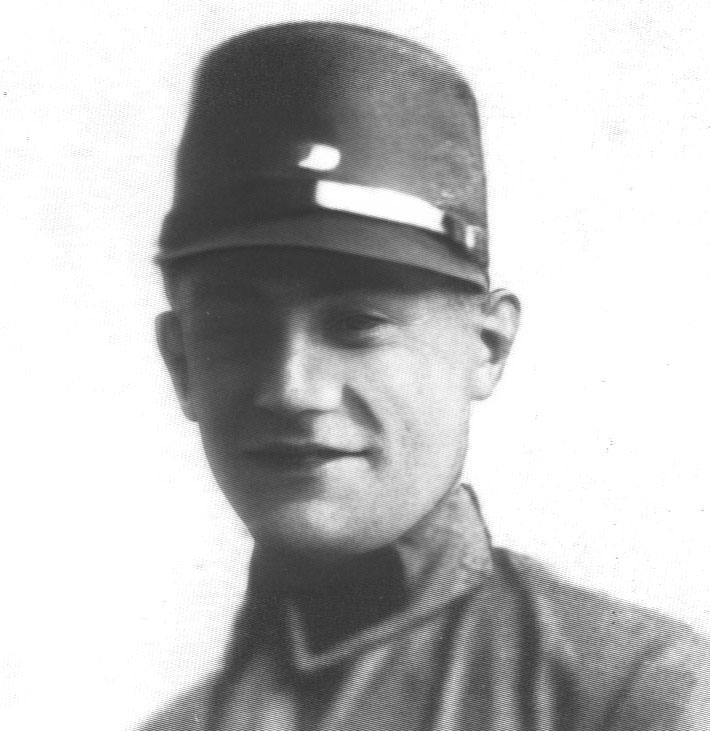
Blood Martyrs of the National Socialist Movement
The Year 1931
Ernst Weinstein
(*4 November 1903, † 1 January 1931 in Stuttgart)

Ernst Weinstein was a resistance fighter against the Weimar Republic and a Blood martyr of the National Socialist movement.
Ernst Weinstein joined the NSDAP in 1926. He celebrated the turn of the year 1930/31 together with eleven other comrades.
New Year’s morning 1931, the citizens of Stuttgart read an extra with horror:
„While thousands and thousands were enjoying themselves with jazz and flirtation and burying the old year to the sounds of the music bands, away from the tribune of merriment a bestial deed took place that could not have been more terrible. Some National Socialists fell victim to Communist incitement, were stabbed in cold blood simply because they belong to a party whose aim is to pull Germany out of the quagmire into which it has fallen. Blood flowed for an awakening Germany. It was a sad end to the year. One after the other, people were stabbed. Again and again one sank to the ground when the murderous steel had completed its criminal work. The warm blood was already running and mixing with the dirt of the street. But the twisted knife heroes were not satisfied yet. They continued to stab mercilessly until their „courage“, the courage of the criminal, turned into cowardice. Just as they had come, in the dark of night, insidiously with criminal intentions, they disappeared again under the cover of darkness when danger threatened them. Only the National Socialists remained behind. But how? Badly wounded, ten of the twelve comrades lay in the street amidst their blood. Massacred by the cowardly hands of murderers. Only now did peace return to the otherwise quiet side street. But a bitter feeling rose in the throats of the bystanders when they saw the consequences of this wicked deed. But it could not last much longer. They were all still alive and all inspired by the hope that Germany would awaken completely, that it would return to itself. They did not fear for their lives, even if they had to give them up, because then it was for a good cause, for a new Germany...“
Of the ten young National Socialists who were seriously wounded, the blacksmith Ernst Weinstein, an SA man from Stuttgart, succumbed to his injuries on 1 January 1931. The fatal steel was in the life, the heart was hit. The immediate medical intervention came too late. Once again the young life reared its head. Ernst Weinstein opened his eyes for the last time and whispered: „Mother, Mother, I’m dying - Hitler, I’ll gladly die for you!
In 1933, a Stuttgart street is renamed Ernst-Weinstein-Straße in honour of the fallen SA man. Likewise a street in Gerlingen (currently Hölderlinsraße). In 1937, Heilbronn’s Ernst-Weinstein-Siedlung (currently: Kreuzgrund) was built, which with its generously sized plots and Volkswohnhaus-type houses was intended as a settlement for self-supporters.
Paul Thewellis
( 3 March 1905, 23 January 1931)

Paul Thewellis (3 March 1905, 23 January 1931) was a resistance fighter against the Weimar Republic and a Blood martyr of the National Socialist movement.
The baker Paul Thewellis had to flee with his parents from Lithuanian-occupied Memelland to West Germany after the First World War. He set up his own business in Birkesdorf near Düren and joined the NSDAP in 1929. In November 1930, the Reich Youth Leader Baldur von Schirach invited Paul Thewellis to an Hitler Youth leaders’ meeting in Cologne. A few days later he was brutally beaten up by communists while distributing party newspapers. He wasted away for weeks as a result.
On 23 January 1931, the Hitler youth Paul Thewellis from Düren died at the age of twenty-five for his Führer and the new Germany.
When the priest visits him again one day before his death, after having already given him the last rites, and admonishes him to renounce National Socialism, the Hitler Youth interrupts the priest with a passionate exclamation, summoning up all his strength:
„I will remain loyal to my leader until my last breath.“
The „Westdeutsche Beobachter“ wrote about this, among other things:
„On 23 January 1931, the Hitler boy Paul Thewellis from Düren died for his Führer and the new Germany. He was one of the young fighters who knew nothing of bloodless doctrines and elaborate systems of political thought. Like so many thousands of German boys, he followed the unadulterated beat of their German hearts. They fought for their German ideal because their blood demanded it.“
After the murder, Paul Thewellis’ parents and four brothers joined the NSDAP.
The Hitler Youth of the Cologne-Aachen Gau set up a worthy monument to him. „Paul Thewellis“ is the name of the area leadership school that was established in Mödrath Castle.
His name was added to the list of the Immortal Allegiance of the Hitler Youth.
Richard Selinger
(*31 January 1909, † 31 January 1931)
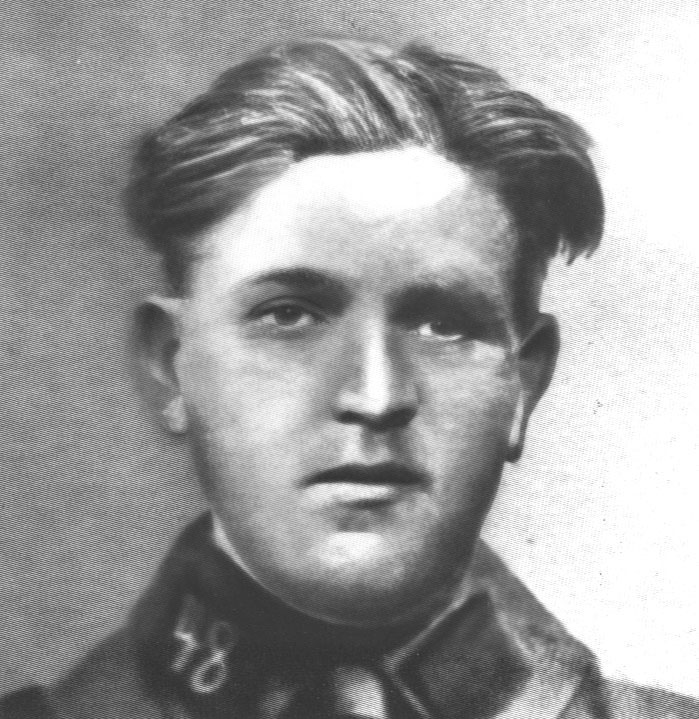
Richard Selinger was a resistance fighter against the Weimar Republic and a Blood martyr to the National Socialist movement.
The SA man Richard Selinger, a farm coachman from Dobers in Upper Lusatia, often had hall protection duty at the SA rally, often in the surrounding area up to forty kilometres away, which he covered by bicycle. Richard Selinger was never absent, although he always had to get up at 4 o’clock the next morning and get the horses. On the night of 30 January 1931 he was again on his way to the Saalschutz. Red highwaymen, who managed to escape undetected, ambushed him on the road to Niesky and fatally wounded him with a shot to the liver. The murderer was the communist Max Barthel. Richard Selinger dies on his 22nd birthday.
Rudolf Schröter
(10 September 1913 in Dresden, 12 February 1931 in Leipzig)

Rudolf Schröter was a resistance fighter against the Weimar Republic and a Blood martyr of the National Socialist movement. He was one of the seven Leipzig Blood martyres of the movement.
Rudolf Schröter attends a rally in the Rheingold Festival Halls in Leipzig. On his way home, the plumber’s apprentice is shot in the back by communists.
Police report
The police report from the „Leipziger Neuesten Nachrichten“ of Friday, 13 February 1931, reports:
„At the rally in the Rheingoldfest halls, a tumult arose after the speech, which degenerated into a serious brawl between National Socialists and dissenters. The police restored calm. Afterwards, the National Socialists departed in unison. In Torgauer Straße they were suddenly fired upon. Several shots were fired, presumably from a window. A 17-year-old plumber and 21-year-old K. were hit. The first was shot in the head, the other in the lower leg. Both were transferred to the St. Jacob hospital.“
The father of the seventeen-year-old boy then received a telegram during the night shift:
„Your son seriously injured admitted to St Jacob’s Hospital.“
Shortly afterwards, another courier arrived with the news:
“Your son passed away.“
The funeral took place on 16 February 1931, escorted by the SA.
Commemoration
In 1939, Graßdorfer Straße in Leipzig-Sellershausen was renamed Schröterstraße. In Dresden-Klotzsche, the National Political Educational Institution (NAPOLA) was given the name „Rudolf Schröter School“. In the spirit of Rudolf Schröter, the seventeen-year-old National Socialist who was shot in 1931 during clashes in Leipzig, young German men were to be educated here to become the next generation of leaders of the National Socialist state. The curriculum of the only elite school of its kind in Saxony therefore included political education and rigorous pre-military training in addition to the classical subjects.
On 8 November 1938, a solemn procession took place in Leipzig, during which the coffins of the seven Leipzig Blood martyres Walter Blümel, Alfred Kindler, Erich Kunze, Heinrich Limbach, Alfred Manietta, Erich Sallie and Rudolf Schröter were first brought from the North Cemetery to the Markt, where the dead were called „to the last roll call“. Instead of them, the formation of honour responded with „Here!“ when each name was called. The coffins were then transferred to the grove of honour specially created for them at Leipzig’s South Cemetery.
His name was added to the list of the Immortal Allegiance of the Hitler Youth.
Gerhard Bischoff
(*22 October 1905, † 28 February 1931 in Steinseifersdorf, Silesia)
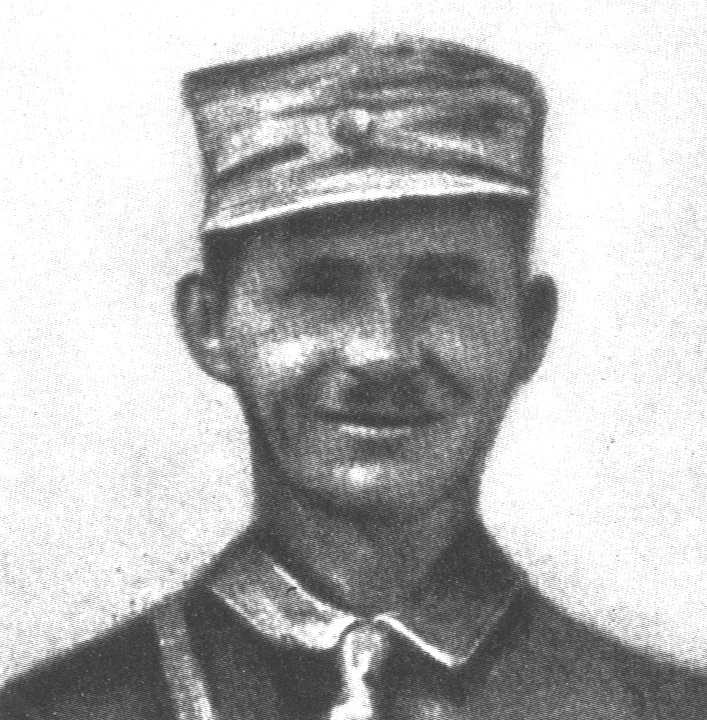
Gerhard Bischoff was a resistance fighter against the Weimar Republic and a Blood martyr to the National Socialist movement.
The flag bearer of Storm 32 in Silesia was Gerhard Bischoff, a farmer from Mlittelpeilau. After a meeting in Steinseifersdorf on 11 February 1931, National Socialists were attacked by Communists. A squad of SA men, including Gerhard Bischoff, rushes to their aid. Thirty brown soldiers fight bitterly against three hundred red attackers who rage with clubs, stones and knives. Thirty against three hundred - but soon the Reds have to leave the field. The flag bearer fell with serious wounds. The young life continues to fight death for more than two weeks, in vain. On 28 February 1931, Gerhard Bischoff dies as a result of the numerous knife wounds.
The murder was also mentioned in a leaflet by the Reichenbach district leader Gerhard Tenschert:
“I am glad that the assassination made it possible to officially expose the National Socialists as a party of murderers! Thus comrade Paeschke speaks in the last meeting of the bonzes and pitchfork youngsters and lets himself be congratulated on his miraculous life-saving. The National Socialists have watched the hysterical behaviour of this pathological agitator in silence for weeks. But now our patience is wearing thin! Now we will settle the score: for years this irresponsible demagogue has been able to spread criminal murderous incitement against the National Socialist movement with impunity in his smear sheet, and has thereby made himself the spiritual author and culprit in hundreds of cowardly attacks against defenceless SA men! We think only of the vicious murder of the SA man Bischof in February 1931.“
In Steinseifersdorf, Gerhard Bischoff Street was named after him.
Fritz Felgendreher
(*14 March 1913, † 14 March 1931 in Essen)

Fritz Felgendreher was a resistance fighter against the Weimar Republic and a Blood martyr to the National Socialist movement.
Filled with the national spirit that prevailed in his parental home, the painter apprentice Fritz Felgendreher from Essen joined the SA on his eighteenth birthday. The chief of staff Ernst Röhm congratulated him personally. On the same day, he joyfully took part in the first march out to the SA’s general roll call. The marching troop was met with gunfire from a night ambush by a hidden communist horde, during which Fritz Felgendreher was seriously injured by several shots to the head. The only one-day-SA-man, Fritz Felgendreher died on his 18th birthday. To replace his fallen son, his father Josef Felgendreher immediately joined the SA.
A street was named in Gelsenkirchen in honour of Fritz Felgendreher.
Adolf Gerstenberger
(*11. 5. 1909 - † 16. 3. 1931)
District Silesia, SA Group Silesia
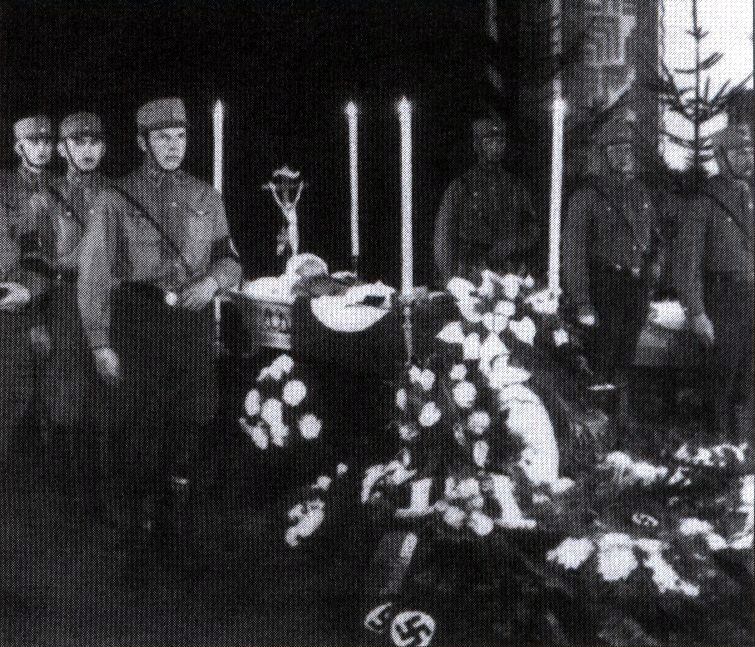
Guard of honour at the open coffin of SA comrade Gerstenberger
It was the order of the day in the young democracy of the Weimar Republic that the groups of the right and left political fringe disrupted or broke up the meetings of their respective opponents. The SPD also took part in this kind of political struggle, maintaining the Reichsbanner Schwarz-Rot-Gold (Black-Red-Gold), a uniformed paramilitary unit to protect its own meetings and to attack foreign meetings and their speakers.
On 15 March 1931, the SA broke up a Social Democratic event in Kauern, Upper Silesia. It is not known whether there were riots or whether the loud noise alone caused the event to be broken up. Afterwards, the SA men wanted to visit another SPD meeting in the nearby Karlsmarkt. In the Winkler restaurant, the Social Democrats allowed a National Socialist discussion speaker in addition to their own. Among the SA men of Sturm 1/157 was the twenty-two-year-old journeyman shoemaker Adolf Gerstenberger.
A contemporary source quotes the dead man’s mother:
„The SPD speaker was Bonze Apfelstädt. A counter-speaker from the NSDAP was party comrade Wagner. Apfelstädt indulged in various insulting remarks. Fearing a discussion, the SPD sought a reason to end the event. Shortly before the end of the speech, a brawl broke out in the courtyard of the pub. During this Gerstenberger was knocked down from behind with a wooden club by the Reichsbannemann Adolf Gerstenberger fainted with a fractured skull, from which he did not awake until his death the following day.“
The young man had joined the party and the Sturmabteilung on 1 March 1930. While his parents were social democrats until the death of their son, Gerstenberger’s brothers belonged to the communists. The family therefore broke off contact with the son and brother and in this way exacted the price for political sentiments. It was his comrades who fed him when Gerstenberger turned up hungry for SA duty. SA-Sturm 1/157 was named after the fallen SA man Adolf Gerstenberger.
Karl Broeske
(*9. 11. 1894 - † 30. 3. 1931)
Gau Essen, SA-Gruppe Rheinland
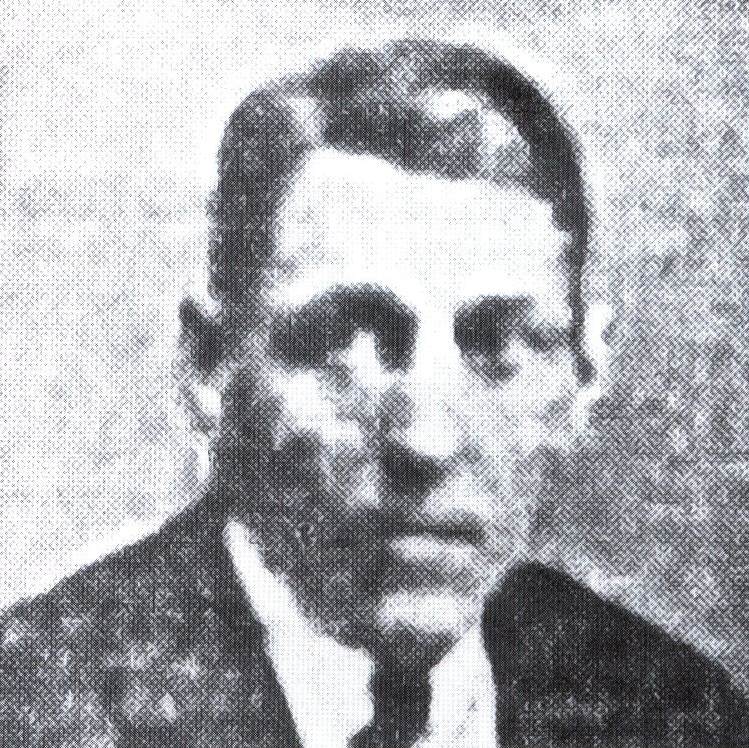
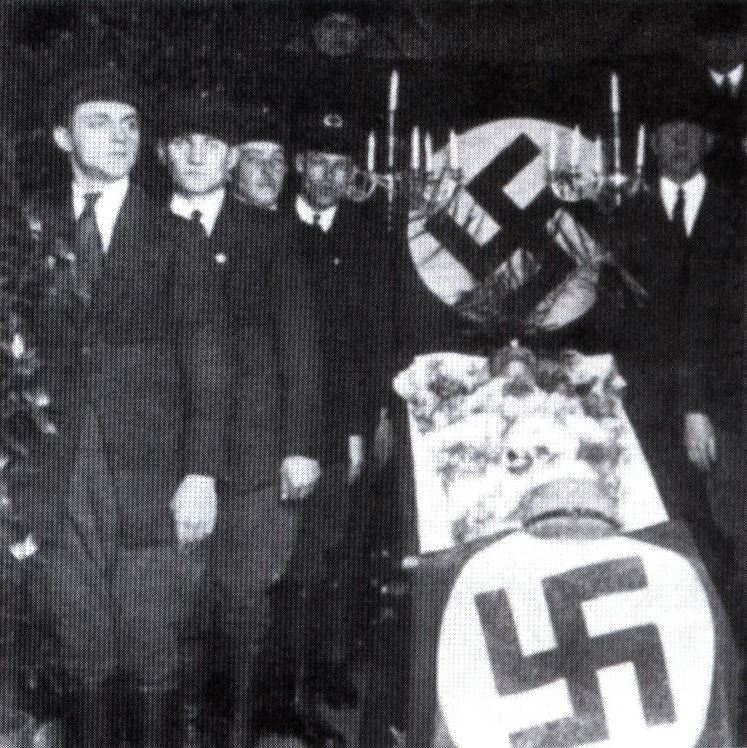
SA in plain clothes at the open coffin of Karl Broeske
Karl Broeske was born in West Prussia and moved with his family to Lünen near Dortmund. After finishing school, he took up the difficult and dangerous profession of miner. In the First World War, the twenty-year-old volunteered for the front and took part in the material battles in the West. Twice Broeske, who was taken prisoner, tried to escape from French camps. On both occasions he was caught and punished with heavy imprisonment. Only when he was about to be shipped to the North African colonies for forced labour did he manage to escape again.
After the war and captivity, Broeske settled in Dinslaken-Lohberg in the Rhineland.
In 1930, the father of five children joined the Sturmabteilung. In the following year, the SA man made a name for himself through his reliable commitment not only among party comrades and SA comrades, but also among political opponents.
The Sturmführer of Broeske’s SA unit reports the violent death of the thirty-six-year-old:
„On Thursday at 8.00 a.m. we held a meeting with our Pg. Stamer. During the meeting about 250 communists who were present in the hall tried to break up the meeting without success. The following day, calls for murder were issued by the communists against comrade Broeske, among others. The following Sunday at 0.30 a.m. Broeske came from Lohberg by bicycle. On Hünxerstr. Broeske heard a woman calling for help. He saw a man hitting his wife and tried to stop the man from hitting the woman, as residents saw from their windows. When the man saw Broeske, he exclaimed that they knew each other from the last National Socialist meeting. The man then pulled out a knife and stabbed Broeske. Broeske immediately collapsed dead. The murderer then fled. When witnesses called him to stop, he threatened them, telling them to mind other business. Broeske left behind a wife and five children, the youngest four weeks old. The perpetrator’s name was Bruno Rasen.“
The perpetrator who killed Broeske by stabbing him in the head and chest was sentenced to 2 1/2 years in prison.
Josef Felzen
(*24 January 1903, † 30 March 1931 in Wittlich)
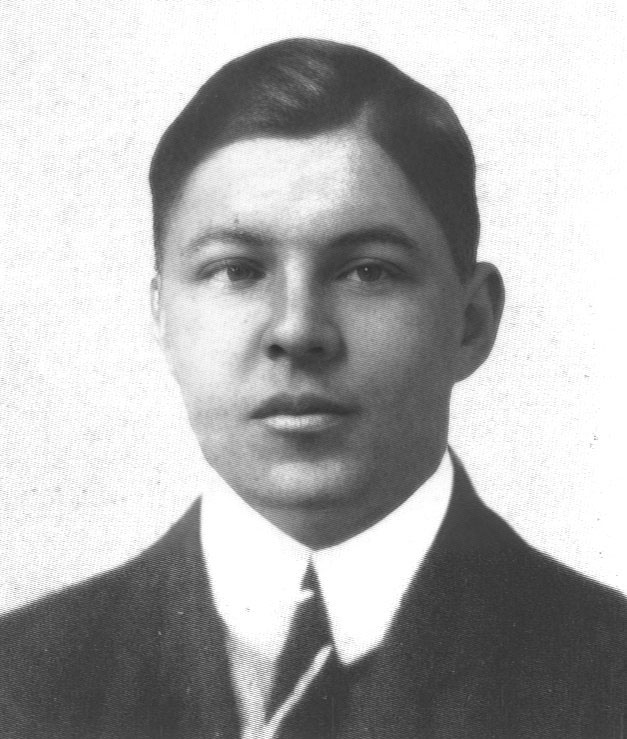
Josef Felzen was a resistance fighter against the Weimar Republic and a Blood martyr of the National Socialist movement.
A loyal SA man was Josef Felzen from Wittlich in the Rhineland. Because he stood up for his fatherland, the French dragged him to prison during the occupation. Afterwards he was expelled from his French-occupied German homeland. But nothing could break the strength of this fighter. In the Eifel he promoted Adolf Hitler’s ideas, and many a breach was made in the ranks of the Blacks and Reds. No work was too small for him, so on 19 March 1931 he went from house to house selling newspapers of the movement and pictures of the Führer. On his way home he was attacked in the dark by communists, knocked down and trampled. Josef Felzen lay unconscious for ten painful days. He died in Holy Week on 30 March 1931. His comrades were only allowed to attend the funeral in civilian clothes, as they were once again forbidden to wear uniforms.
Karl Wilhelm Freyburger
(24 August 1904 - 27 April 1931)

Karl Wilhelm Freyburger was a resistance fighter against the Weimar Republic and a Blood martyr to the National Socialist movement.
Karl Freyburger came from Thuringia. During the French occupation, he went to West Germany to work in the resistance struggle against the occupiers. Afterwards he went to East Prussia.
A loyal, active fighter for the movement was the SA Sturmbannführer Karl Freyburger in Liebstadt in East Prussia. Because of his convictions, he lost his position as an animal breeding inspector and made every sacrifice for National Socialism. Thus he was persecuted by the hatred not only of the Reds but also of the Marxist-minded sections of the police. On his way home from a National Socialist celebration in Deutsch-Eylau on 26 April 1931, he was stopped by policeman Granitza and asked to show his identity papers. Without Karl Freyburger giving cause, another officer in civilian clothes suddenly approached him and beat him with a stick; the attacked man defended himself, Granitza drew his service pistol and shot Karl Freyburger in the head, to which he succumbed the following day.
The chronicle of the district of Stradem, where the murderer lived, states:
„Like a beacon, on 27 April 1931, the news of horror ran through our village that the Sturmbannführer Karl Freyburger had been shot dead by the policeman Granitza in front of the Esthner bookshop in Dt.-Eylau in the night of 26-27 April.“
In Allenstein, Danzig and Deutsch-Eylau streets are named after Karl Freyburger. In Elblag it becomes the „Karl Freyburger Way“.
Fritz Tschierse
(*1 December 1906, † 23 May 1931 in Königsberg (Prussia))
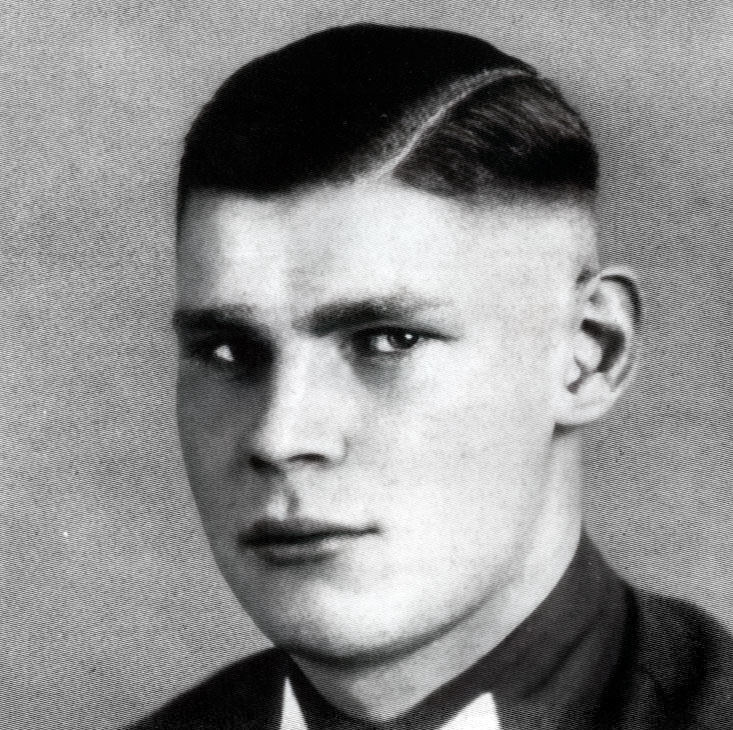
Fritz Tschierse was a resistance fighter against the Weimar Republic and a Blood martyr of the National Socialist movement.
Fritz Tschierse was an enthusiastic motor sportsman and also wrote as a correspondent on this subject in the Preußische Zeitung.
On 23 May 1931, the SA man Fritz Tschierse returns from a big motorbike tour. He is mobbed because of the swastika pennant on his bike. He is pulled down and four communists stab him. Afterwards they continue to kick the seriously injured man lying on the ground. Fritz Tschierse dies of internal bleeding. The main perpetrator, Jordan, leader of the Königsberg Red Front Fighters’ League, fled across the Baltic Sea to Russia.
Gesekusplatz in Königsberg bears his name in the Third Reich. In Neidenburg, a street bears his name. In Elbing it is the Fritz-Tschierse-Weg.
Paul Billet
(* 20 April 1905 in Lahr, † 25 May 1931 in Karlsruhe (Baden))

Paul Billet was a resistance fighter against the Weimar Republic and a Blood martyr of the National Socialist movement.
On the occasion of a march, the machine master Paul Billet from Lahr comes to Karlsruhe with his SA motor storm. The men are considerably provoked, but remain disciplined. Billet drives the last motorbike in the procession on Kaiserstraße at the height of Adlerstraße. He is surrounded by 50-60 communists, torn from his motorbike and suffers a skull injury from blows from a stick, to which he succumbs on 25 May 1931, Whit Monday. Many thousands of Germans accompanied him on his last walk.
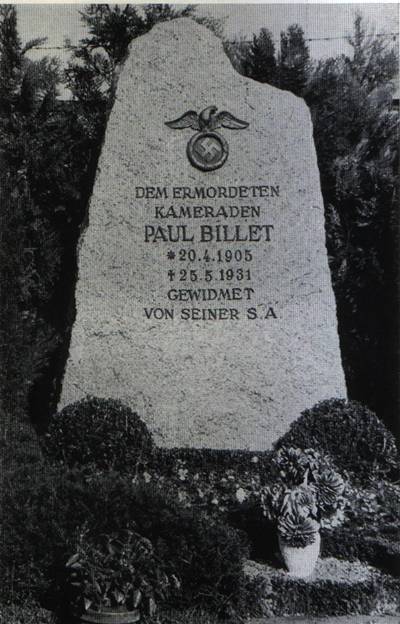
Later, a street in Mannheim was named after him. The trade school in Lahr also bore his honorary name. On 23 November 1935, a monument was unveiled at the site, which was removed in June 1945 on the orders of the French occupying forces.
Gerhard Liebsch
(3 December 1913, 26 May 1931 in Dühringshof (Brandenburg))
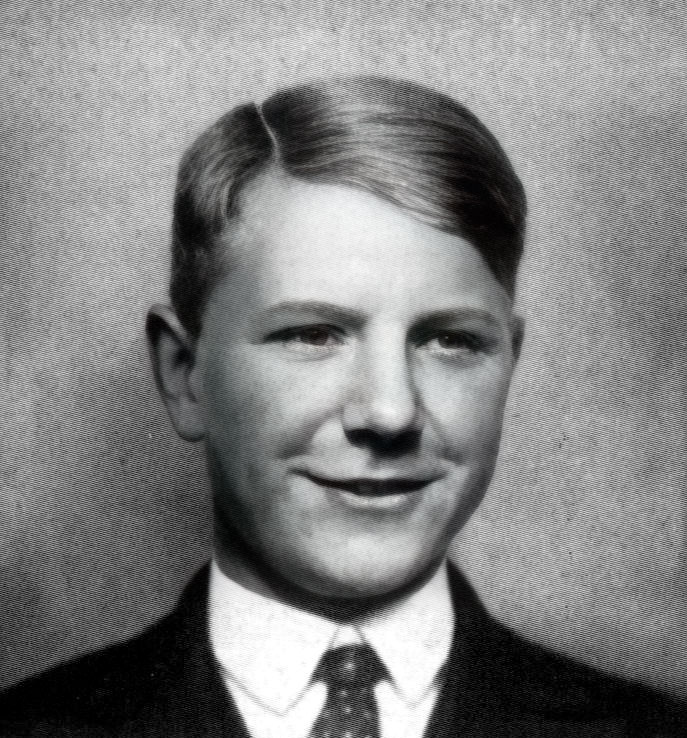
Gerhard Liebsch was a resistance fighter against the Weimar Republic and a Blood martyr to the National Socialist movement.
Gerhard Liebsch has been looking forward to this for a long time: to get out of the cairn of Prenzlauer Straße in Berlin for the holidays. He will go to his brother’s house in Dechsel, in the Landsberg area. Now, at last, the time has come. With all the strength of his almost eighteen years, he looks forward to the bright spring. And then something especially nice: on the second holiday, 26 May, he and his „big“ brother, the SA man, go over to the neighbouring Dühringshof, where the football club has its big day. After the game, they are together in the clubhouse, all cheerful, fresh-faced boys, and they sing and play music, and young Gerhard joins in with all his heart. Suddenly, in the evening, there is a hooting and jostling from outside. Red athletes, watch out! Before anyone knows what’s going on, a furious brawl is underway. Gerhard Liebsch is wearing his HJ badge, he is the target. But he fights back with both fists and helps to beat the Reds out of the hall, despite their superior strength. Gerhard Liebsch goes out alone to get more help. He does not come back. Before he can utter a sound, the dagger pierces his heart. Dying, he lies on the ground as his killers stomp on him, spitting at him and mocking his defenceless wounds. Then they flee. Gerhard Liebsch dies at the age of seventeen. One of the communist murderers is convicted, but after 1 1/2 years he is released. It was not until 1933 that the murder was fully solved.
„The Young Stormtrooper“ reports on the murder:
„Unpunished murder! On the night of 26 May, the Hitler boy Gerhard Liebsch was murdered in a bestial way by Marxists. In December, the trial took place in Landsberg a.d.W.. The accused were the Marxists Siepelt and Rudolf. The murder itself could not be completely proven. However, it could be proven that the two defendants, after stabbing the Hitler boy with a 16 centimetre long dagger and rolling on the ground in his blood, kicked and trampled him in an animal-like manner.“
The newspaper Der Angriff also reported:
„A Hitler Youth stabbed! The corpse spat on.“
The gravestone in Landsberg an der Warthe bears the saying:
„His sacrificial death was for the freedom of the nation“.
A street in Pfaffenhofen is named after Gerhard Liebsch.
On 29 November 1936, the NSDAP inaugurated a memorial stone for five Blood martyres in Berlin. One name on this stone was Gerhard Liebsch. The memorial was located opposite the Horst Wessel House at Prenzlauer Straße 62 until the temporary „liberation“ in 1945.
His name was added to the list of the Immortal Allegiance of the Hitler Youth.
Heinrich Gutsche
(* 16 September 1909, † 7 June 1931 in Chemnitz)
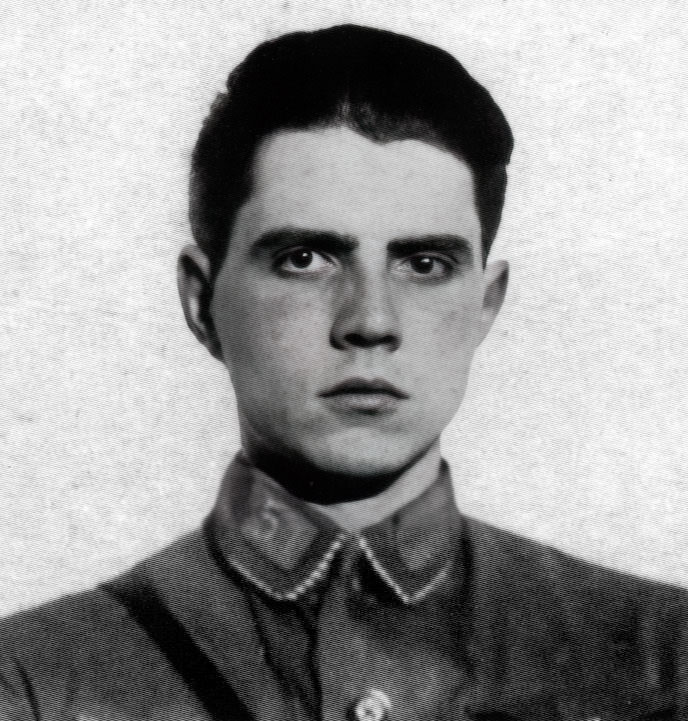
Heinrich Gutsche was a resistance fighter against the Weimar Republic and a Blood martyr to the National Socialist movement.
On 6 and 7 June 1931, the Saxony district of the NSDAP held its party congress in Chemnitz. Thirty thousand National Socialists have come together to once again show their loyalty to their leader Adolf Hitler in the fight for justice and freedom. On the evening of 6 June, a torchlight procession of the Brown Shirts shines through the streets of Chemnitz. At an early hour on Sunday morning, a motor vehicle manned by SS men drives through Brühl, past a „Red Help“ shop. There the red juggernaut boiled in furious hatred, spewing out cowardly from the ambush, hailstones and bottles and coals. This would have to be SS not used to fighting, who do not rush down from the wagon and answer the Marxist with bare fists. The communists rage with knives and pistols, six National Socialists are injured. One of them was the SA man Edgar Steinbach, the other was the SS man Heinrich Gutsche. The engineering student from Mittweida is shot in the stomach and taken to the Küchwald hospital. He bears the pain with heroic acquiescence, his eyes shine with hot joy when Der Führer Adolf Hitler, who had just been present at the Gau party conference and heard about the two seriously wounded men, comes to his deathbed. He breathes the last words, „Heil Hitler!“. The cold hand clasps white carnations brought by the Führer.

The Führer on his deathbed by Heinrich Gutsche
The priest’s words ring out over the final resting place of Edgar Steinbach and Heinrich Gutsche:
„Be thou faithful unto death, and I will give thee the crown of life.“
Edgar Steinbach
(* 10 January 1910, † 7 June 1931 in Chemnitz)
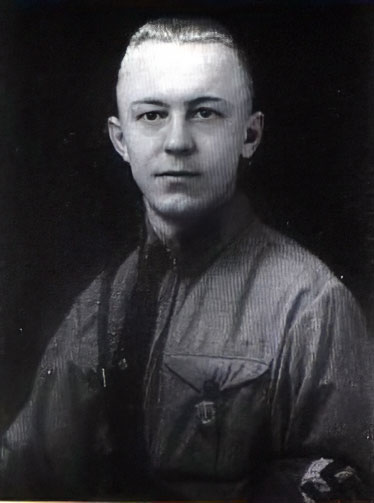
Edgar Steinbach was a resistance fighter against the Weimar Republic and a Blood martyr to the National Socialist movement.
On 6 and 7 June 1931, the Saxony Gau of the NSDASP holds its party congress in Chemnitz. Thirty thousand National Socialists have come together to once again show their loyalty to their leader Adolf Hitler in the fight for justice and freedom. On the evening of 6 June, a torchlight procession of the Brown Shirts shines through the streets of Chemnitz. At an early hour on Sunday morning, a motor vehicle manned by SS men drives through Brühl, past a Red Help shop. There the red juggernaut boiled in furious hatred, spewing out cowardly from the ambush, hailstones and bottles and coals. This would have to be SS not used to fighting, who do not rush down from the wagon and answer the Marxist with bare fists. The communists rage with knives and pistols, six National Socialists are injured. One of them is the SA man Edgar Steinbach. He is young, wonderfully young, still at school as an upper-secondary student, and yet he has known the struggle of the German youth for many years. In 1923 he founded a local group of the Young National League. His affiliation to the NSDAP is a thorn in the side of the teachers, and he has to change schools three times because of it. It is made impossible for him to take the Abitur at a Saxon school, so he turns to Dr Frick and Klagges in order to be able to take the Abitur in Thuringia or Brunswick. Then came 7 June 1931. The assassin’s bullet that hit him in the neck took his young life. Edgar Steinbach fell next to his brother Alfons, who was also seriously injured. His mother and three brothers, all old members of the NSDAP, mourn him. A comrade in this fight accompanies him into eternity, SS man Heinrich Gutsche. The Führer Adolf Hitler, who was present at the party conference and heard about the two seriously injured men, visited them at their bedside.
The priest’s words ring out over the final resting place of Edgar Steinbach and Heinrich Gutsche:
“Be thou faithful unto death, and I will give thee the crown of life.“
In Chemnitz, Linienstraße is renamed Edgar-Steinbach-Straße. After the occupation of Germany in 1945, it had to be temporarily renamed again.
Josef Weber
(*4 October 1903, † 16 June 1931 in Ebersberg (Upper Bavaria))
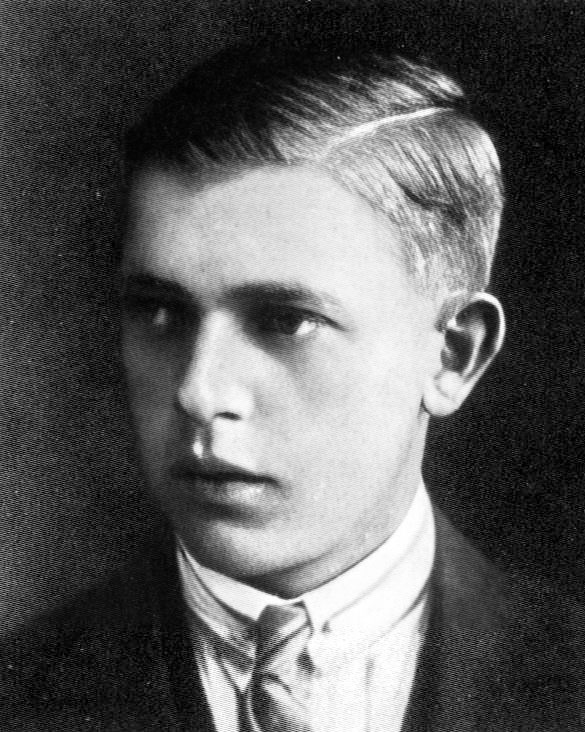
Josef Weber was a resistance fighter against the Weimar Republic and a Blood martyr of the National Socialist movement.
On 16 June 1931, after suffering for more than ten weeks, the SA man and painter Josef Weber of Sturm 58 in Ebersberg (Obb.) dies as a result of his terrible injuries, which were inflicted on him in a vicious manner by Ebersberg Red Guards. It is 29 March. Pg. Weber is attacked and knocked down by about thirty members of the Reichsbanner in the „Oberwirt“ inn. The dehumanised beasts then trampled on their victim with boot heels, kicked him in the abdomen and maltreated him with chair legs. While his comrade got off lightly, Weber died of a ruptured abdominal mesh. Adolf Hitler escorts him to his last walk. The local priest, Vitus Grain, forbids the wearing of party insignia during the funeral and only allows uniforms into the cemetery after the church ceremony. The murderers were acquitted by the system judges of the time.
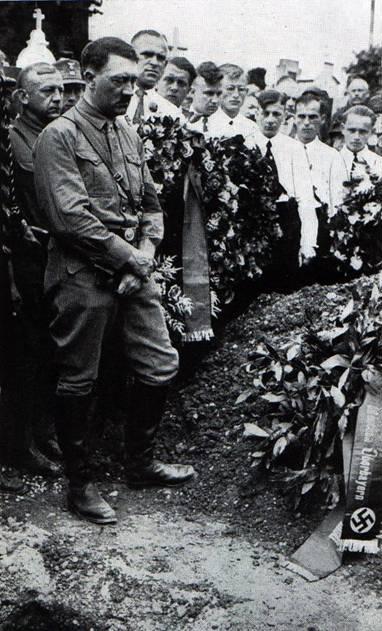
The Führer at the grave of Josef Weber (Obb.) fallen on 16 June 1931
Lahnewiesstraße in Garmisch-Partenkirchen was called Josef-Weber-Straße until the occupation of Germany in 1945.
Edgar Müller
(* 4.8.1909 - † 19.6.1931)
District Silesia, SA Group Silesia
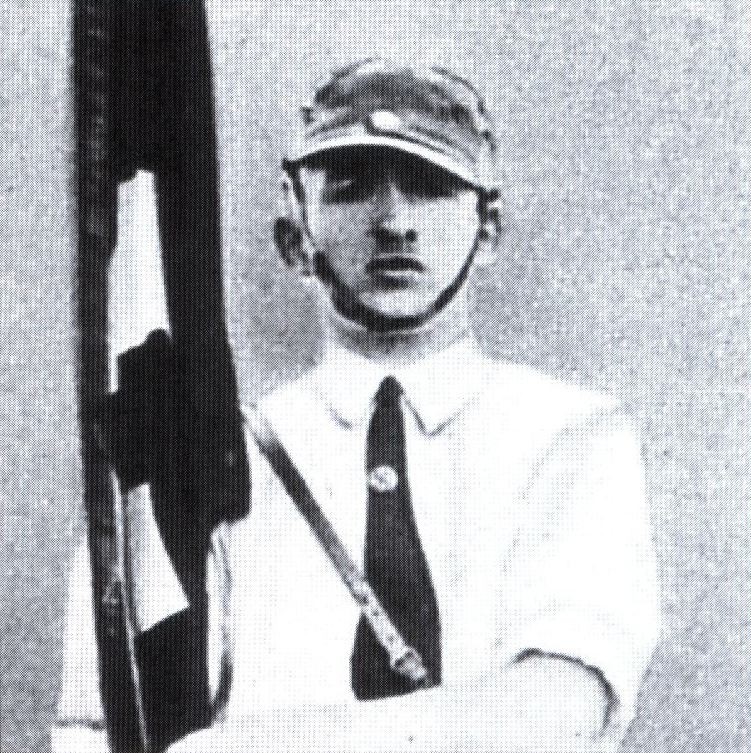
During the fighting for Upper Silesia in 1919, Edgar Müller’s father was taken to Krakow by Polish irregulars. Together with the men of the Silesian Self-Defence, the ten-year-old participated in the search for the customs officer over several days. After the Poles released the man, the family moved to Neisse in Upper Silesia. There Edgar Müller attended grammar school and then successfully completed a commercial apprenticeship. Later he worked in Reichenbach in Silesia and in Berlin, where he first came into contact with the National Socialist movement.
Müller attended several National Socialist events and was wounded by a leg shot by political opponents during an altercation in the Tiergarten area. The necessary hospitalisation cost the young man his job.
After his return to the old fortress town of Neisse, which was nicknamed „Silesian Rome“ and was politically dominated by the Centre Party, Müller set up an SA unit there.
In 1929 and 1930, the Schar expanded into the Sturm, which initially bore the designation Sturm 5, Standarte 2, Ratibor. Through various reorganisations, Müller later belonged to the SA Sturm 22/23 as SA Scharführer and flag bearer.
There had already been a knife attack on an SA man in the city the night before the fatal assault.
On the evening of 19 June 1931, some communists mob the SA man Grospietsch and chase him through the old walls of the city. Edgar Müller is on guard duty in front of the Slurm pub in Schulstraße when the report of the harassed comrade arrives. The „Völkischer Beobachter“ reports contradictorily here that after the police refused to pursue the perpetrators, Grospietsch would have gone to the SA traffic pub himself.
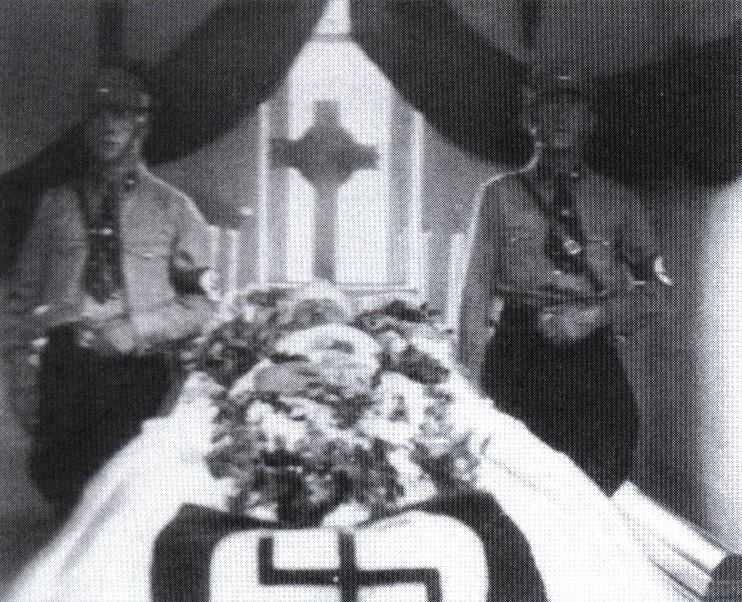
Wake at the open coffin of SA Scharführer Edgar Müller
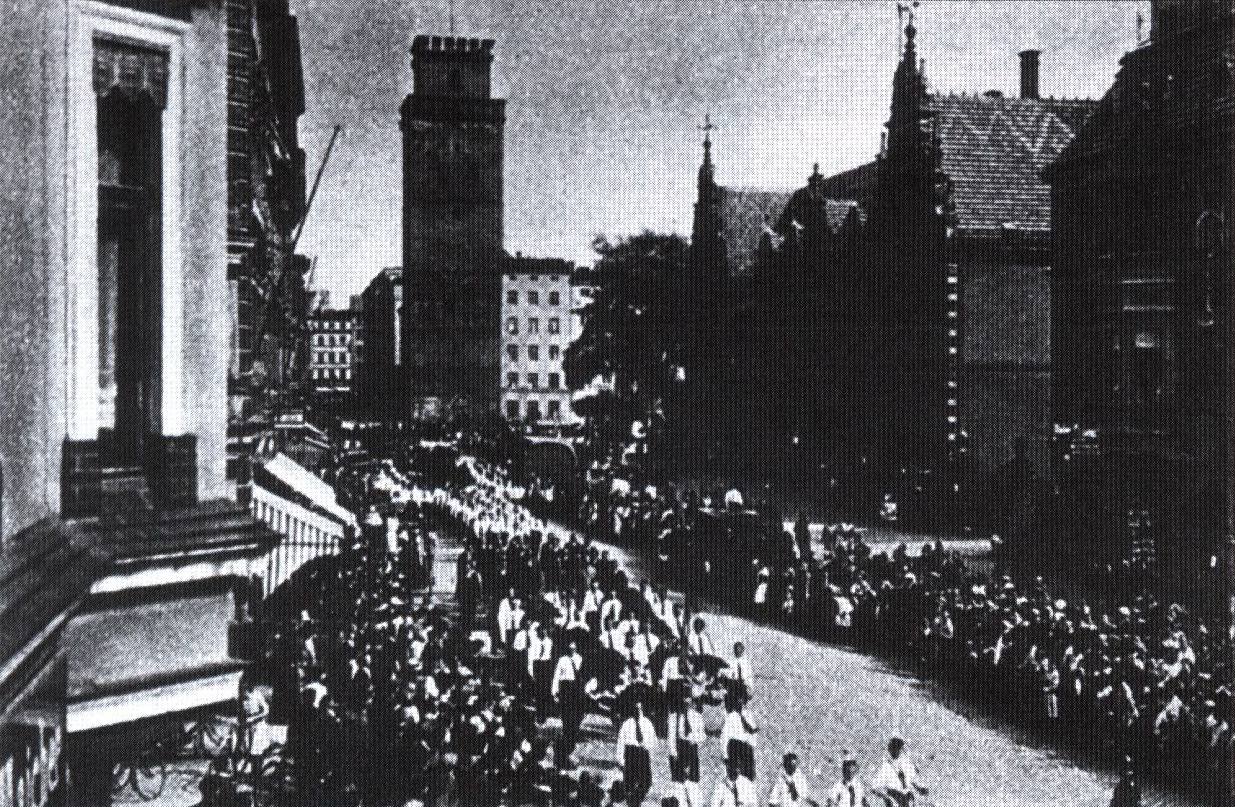
Funeral procession for Edgar Müller. His SA comrades follow the coffin in white shirts because of the ban on uniforms.
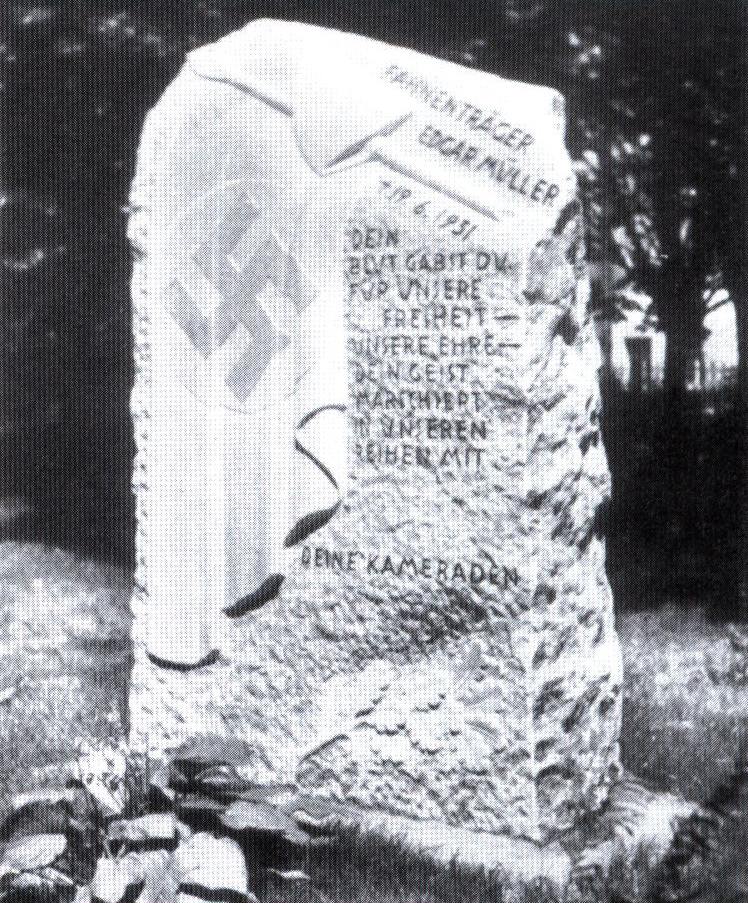
The gravestone of Edgar Müller
At the command „storm alarm“, the men jump into the street to reach the scene at a run. Between Schreinerstrasse and Steinstrasse, the small unit receives fire from an ambush for the first time. The bullets, however, are poorly aimed and inaccurate. A group of communists, now fleeing from the SA, splits at one of the next street corners into Kastner- and Steinstraße. Scharführer Müller is the first of his squad to rush around the corner into Kastnerstraße. At that moment, shots hit the young SA man in the arm, chest and back from a short distance. Müller’s SA comrade Gebel is able to pull the lifeless body out of the field of fire. When the police arrived a short time later, the seriously injured man and his comrades were searched for weapons. Only then did the officers take the wounded man to hospital, where he died shortly afterwards.
Three days later, the communists Steiner, Butta and Franke were arrested. After the men were set free again, all three fled to Russia.
Since some of the SA men are sentenced to several months in prison, and one source reports that Müller was also hit by a police bullet, it can be assumed that the Sturmabteilung did indeed put up considerable resistance.
Seven hundred SA men in white shirts, together with their SA group leader and the Gauleiter, carried their young standard-bearer to his grave.
Johann Gossel
(*1 January 1900, † 21 June 1931 in Bremen)

Johann Gossel was a resistance fighter against the Weimar Republic and a Blood martyr to the National Socialist movement.
At the age of eighteen, Johann Gossel fought in the First World War against the overwhelming power of the states that had declared war on the German Reich. In 1928 he became a member of the NSDAP.
It is the journey home from Hanover that the cycling group of Storm 3 in Bremen undertook on 14 June 1931. And now they have arrived in Bremen, a few more streets and they are home. The last of the eight cyclists is Johann Gossel, a worker and SA man. They pass the Huckelriebe. The people in front hear a noise behind them, a roar, get off the bike, what’s going on? A crowd, where is Gossel? There, they see it with horror, a horde of fierce figures surrounds him, from ambush they rush out, on the last one, whom they lay in wait for. Before he is off the wheel, the murderers surround him, the knives strike into his head and back and body. In a matter of seconds, his comrades are with him, then it comes out of the nearby commune, the murderers receive supplies, a hundred highwaymen against eight SA men! No, against seven. The eighth, Johann Gossel, is lying dead on the ground. Paramedics arrive, and the inhuman happens: The murder pile hinders the Samaritans in their work, they do not allow the wounds to be dressed. On 21 June 1931, Johann Gossel succumbed to his wounds. He is the first dead of the Bremen SA.
Johann Gossel’s last words are:
“Some people may think whether what I have done is right or not. I know that I have acted rightly and when I die I want to be buried in a brown shirt. I die for my fatherland.“
The square near the Hucketriebe where he was murdered was named „Johann Gossel Park“ in the Third Reich, and the former „Red House“ of the Communist Party in Buntentorsteinweg in Bremen was named „Johann Gossel House“, home of the Sturmbann III/75 on 22 April 1933. A monument to Johann Gossel was erected in Huckelrieder Park in 1934. His name was carved in stone, decorated with a swastika.
Oskar Piepgras
(*26. 2. 1909 - † 1. 8. 1931)
Hamburg
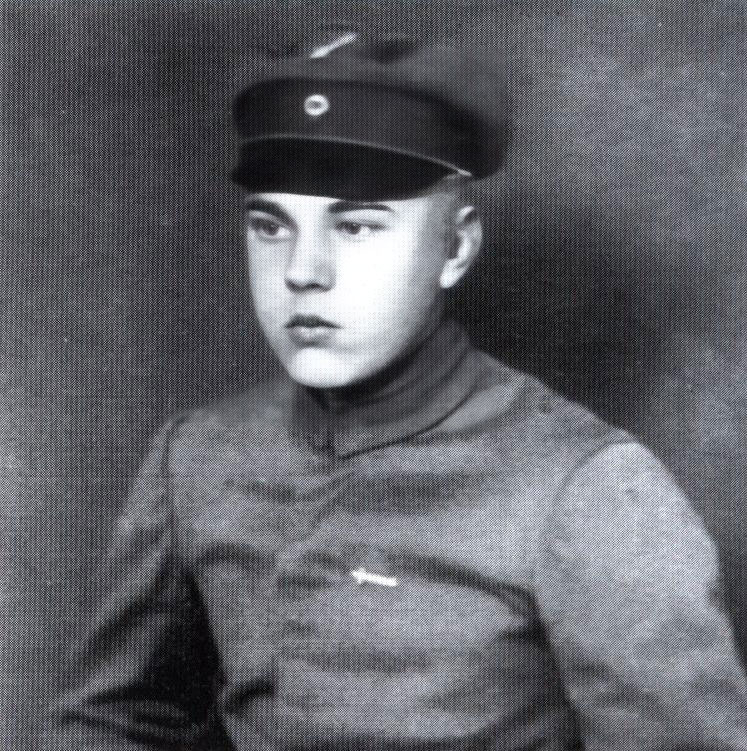
The fallen of the Stahlhelmbund are usually not mentioned in lists and descriptions on the subject of Blood martyres of the National Socialist movement. However, information on these dead is often found in sources with a regional reference, synonymous with fallen SA and SS men.
On 6 March 1934, the Stadl Hamburg named the former and current Biosweg after the sixteen-year-old murdered young steelworker Oskar Piepgras.
The press describes the events surrounding the young man’s death and the subsequent trial:
„1. 8. 1931 A political murder? - The Piepgras affair
Last night at around 1.00 a.m., a student was knocked down in Stormamer Straße by three men who escaped unidentified.
Police officers called to the scene found Oskar Piepgras, a student born on 26 February 2009 in Kappeln/Schlei, lying on the ground with a bullet in his back. The shot man, who is said to belong to the Stahlhelm, died during transport to hospital.
The police assume that the man who was shot had an exchange of words with dissidents at the Friedrichsberg suburban railway station. Who can give information about where Piepgras was during the night?
1. 8. 31 (Saturday)?
2. 8. 31 The Piepgras case
In this case, it was established that the murdered man had visibly worn his steel helmet badge on Friday. It was not found on the body. On Friday evening, Piepgras had left his workplace in the inner city around 7.30 p.m. and visited several pubs. Around 0.15 a.m. he said goodbye to a friend in Kirchenallee and went to the main railway station. He may therefore have already taken the 0.22 train in the direction of Barmbek.
Piepgras was found in front of the house at Stormamer Str. 1. Four men are said to have been seen there, who went to Ahrensburger Straße without taking care of the injured man. The investigation is being conducted by Criminal Investigation Department 7 (City Hall). A reward of RM 1000 is offered for the apprehension of the perpetrators. Political motives are presumably at the root of the crime.
7. 8.1931 In the Piepgras murder case, the 29-year-old worker Karl Voss was arrested on urgent suspicion. [...] He has been recognised in particular by other witnesses who had also been subjected to violence during the night. It has been observed that every time people with steel helmet badges came out of the station, they whistled. [...]
11.8. 1931 In the Piepgras case, the alibi evidence of Voß collapsed. An arrest warrant was issued against him on suspicion of murder. In the meantime, three more persons have been arrested. Other arrests are still pending 3. 1932 Piepgras murder case in court:“
The steel helmet soldier Piepgras was stopped by the stone carrier Karl Voß, born in 1902, in Stormamer Straße. Voß took away a young steel helmet badge worn by Piepgras and hit him on the forehead with his head (so-called Danish kiss). At this moment a certain ‘Fritz’ came and shot Piepgras in the back. The gunman, a communist named Waldemar Harm, presumably escaped to Russia. He has not been identified. Of the other perpetrators, the following were identified and charged: Herbert Wilkens (gen. Ebers), born 1913, Emst Brunow, born 1909, Emst Henck, born 1914.
You are charged with aggravated breach of the peace. [...]
1.4.1932 Voss was sentenced to 1 year in prison for bodily harm by means of deceitful assault. Bruno received 5 months in prison, Henk and Wilhelms 3 months each.
24. 7. 1932 In the murder case Piepgras was sentenced after an appeal hearing against: Voß 15 months in prison, Bruno 8 months in prison, Henk 5 months in prison“.
In addition to these lenient sentences, the court, presided over by the two judges Dr Stuhlmann and Dr Tyrolf, acquitted two other defendants.
Only minutes before the murder of the young steelworker, two of his comrades had also been attacked and maltreated by communists near the station building in the Hamburg district of Barmbek.
The written verdict sets out the sequence of events of the murder as follows:
„Shortly before 1/2 1 o’clock, the member of the Stahlhelm Piepgras, a young student, arrived in Friedrichsberg with a suburban train. When Piepgras left the station, the accused Voß followed him. The witnesses Mäding and Zamcke observed this and set off to follow Voß and see what would happen. [...] When Piepgras and Voß turned into Stormamer Straße, the witness Mäding kept close behind Voß, who in turn caught up with Piepgras at about Liedke’s inn. [...] The witnesses Gärtner and Luttermann had walked about 10-20 m behind Piepgras through the Anlagenweg towards Stormamer Straße. From this distance they saw what was now happening.
The accused Voss grabbed Piepgras with both hands from the chest at the lapels of his skirt when he had caught up with him at Liedke’s inn. He noticed Piepgras’ young steel helmet badge and asked him in Low German what it was and where he had been and made Krakehl. Piepgras replied that it was a badge, that Voß should let him go, that he had done nothing. Voß then tore off his steel helmet badge and at the same time hit him on the chin with his head from below, so that Piepgras staggered from the kerb of the pavement onto the roadway, but did not fall because he was held down by Voß.
Piepgras, still held by Voß, stepped back up onto the pavement, while Voß remained standing on the roadway, so that their heads were about the same height, although Piepgras was smaller in stature than Voß. [...]
At the same moment, a long young person, who had so far remained undisclosed, came out of the bushes of the grounds from behind towards Piepgras, embraced him from behind for a moment and then put one hand, in which he was holding something, on his back. [...] When the unidentified person had put his hand on Piepgras’ back, he asked the witness Mäding in Low German ‘Do you want or should I?’, but when Mäding did not immediately understand the meaning of these words, he immediately continued: ‘You must not hesitate that long’ and shot. [...]
He himself [witness Mäding] saw Piepgras staggering a few steps over the embankment and then collapsing with the words ‘0, how mean!’, then he [witness Mäding] also quickly left. [...] Piepgras died shortly afterwards. „
For all the accused and the witnesses, as far as they belonged to the group on the station forecourt, the court proved that they belonged to the Communist Party or the Communist Youth. The public prosecutor suspects that the
Stone carrier Voß even a functionary of the banned Red Front Fighters’ League. The prosecution demanded a much harsher punishment, which is stated in the indictment:
„[...] There is also the suspicion that, even if Voß did not shoot himself, the murderer who has not yet been caught - Waldemar Harm, who has fled to Russia in the meantime, is the most heavily incriminated - acted with Voß’ knowledge and will. However, there is no proof of this. [...]“
The public announcement on the death of the Stahlhelmers and the reward of 1.000 Reichsmark describes the appearance of the young victim and the nature of the fatal wounding:
„Description of Piepgras: 1.76 metres tall, slim, elongated face, blond, wavy, left-parted hair, wore brown, patterned single-breasted jacket suit with two buttons, without waistcoat, yellowish upper shirt, white, soft collar, light patterned self-tie, brown socks, black patent leather half-shoes. [... ]
He [Piepgras] died during transport to the hospital. According to the result of the forensic medical examination, death occurred as a result of internal bleeding. The bullet, which penetrated the back, pierced various noble parts and got stuck 5 centimetres below the left nipple. According to the judgement of a shooting expert, it was a steel jacket bullet, calibre 6.35, which was probably fired from a new self-loading pistol. [...]“
Oskar Piepgras was born in Kappeln an der Schlei in Schleswig-Holstein and started school in the small town in 1914. He later attended secondary school and then the „Klaus-Harms-Schule“ until he passed his Abitur. Initially, Piepgras belonged to the local Boy Scouts before joining the „Stahlhelm - Bund der Frontsoldaten“ after founding a Stahlhelm local group in 1926. About two years later, Oskar Piepgras moved to Hamburg, where he started a commercial apprenticeship, after which the chief bachelor of the Stahlhelmbund wanted to study.
In the front of the Stahlhelmer, the SA leaders stood during the funeral service and gave their last respects to their grey comrade. Communist troops tried to disrupt the burial of the farmer’s son.
The mother of the deceased concluded the details of her son’s life, published in a contemporary source, with the words:
„He was our pride and our hope!“
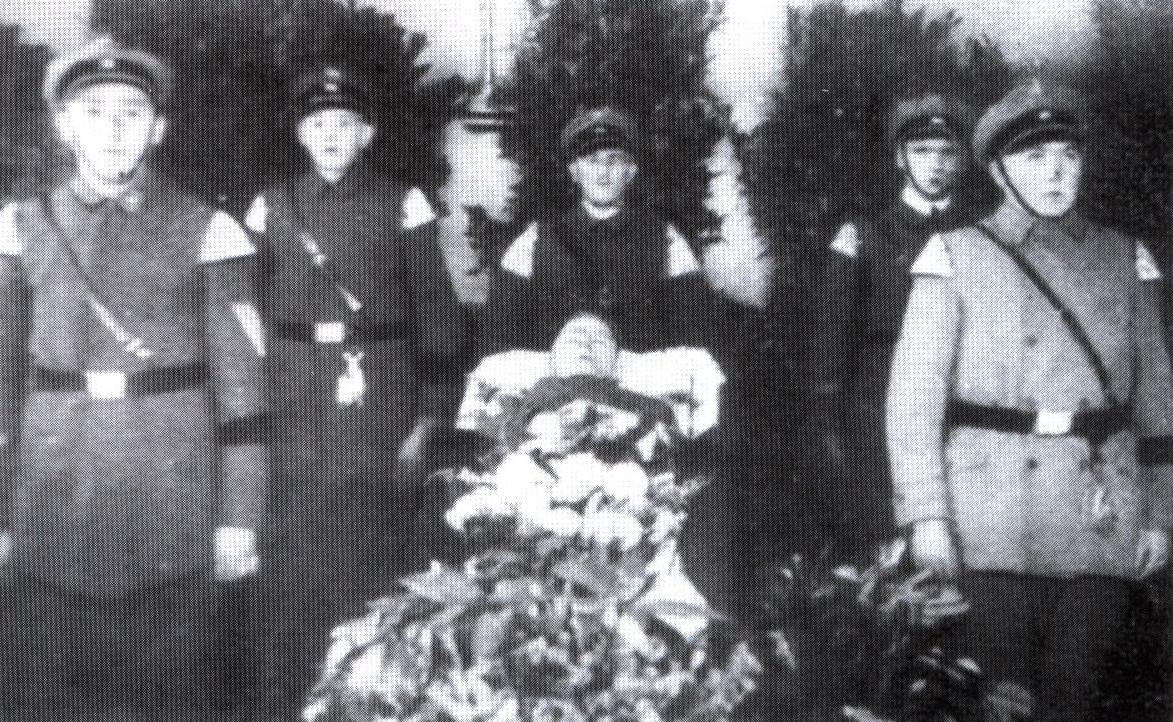
Honorary guard of the Stahlhelmbund at the open coffin of the murdered Oskar Piepgras
Fritz Schröder
(*30.6.1908 - † 1.8.1931)
District Großberlin, SA Group Berlin Brandenburg

The SA man Fritz Schröder does not appear in any supra-regional list of the NSDAP as a Blood martyr of the movement. Even in contemporary accounts of the fighting period in Berlin, the young carpenter is only mentioned briefly. The SA man Fritz Schröder only became known long after 1945 through the processing of his violent death in a song lyric.
The twenty-three-year-old was a member of SA Storm 41 in the red Berlin district of Wedding.
After the storm evening in the Cafe Seerose, Fritz Schröder was attacked by political opponents in Müllerstraße in front of house number 136, on the corner of Seestraße, and injured so severely with brass knuckles that he died as a result of the wound.
Walter Blümel
(* 1 March 1908 [other information: 7 September] Erfurt, † 2 July 1931 in Leipzig)

Walter Blümel was a resistance fighter against the Weimar Republic and a Blood martyr of the National Socialist movement.
The young worker and milker from Leipzig came to the Rhine and found work there. The German Rhine was an experience for him, he got to know it during the French occupation, and what he saw on the Rhine remained in his heart. When Walter Blümel returned to his hometown, he was no longer the funny, high-spirited boy who had gone out. Serious and quiet, he said:
“I have seen Germany bleed!“
His life became a service to the Fatherland. Wherever he went, he preached Germanism, carried away the people with his enthusiasm. In 1930, he and two brothers joined the NSDAP and the SA. He fought and campaigned for Adolf Hitler, and as an SA man in Leipzig’s Sturm 62 he served tirelessly, despite wind and weather, despite slander and persecution. The house he lived in with his mother and siblings was in Leipzig’s reddest district. Soon, thanks to Walter Blümel’s restless work, it was a National Socialist stronghold, an island in the Marxist surf. The enemies swore revenge on him. In his heart he suspected that he would have to become a victim for the great idea. When he attended the funeral of two SS men in Chemnitz, he said to his comrades: „I would also like to be buried like that one day“, and after a long pause, quietly:
„Promise me you’ll sing: I had a comrade.“
But all the premonitions of death never let him tire in the struggle. On the evening of 2 July 1931, he was reading a book and put it down with the words: „I don’t think I’ll ever finish it. He says to his mother:
„I feel so peculiar today, I would rather stay away from duty today.“
But he pulls himself together, duty is duty. With twenty comrades he marches through the streets, when the communist murdering rabble bursts out of the darkness in multiple superiority; they avoid the proximity of the fists of brown fighters, stones and pistols are the weapons of the Reds. Three bullets put Walter Blümel to death. Two brothers, a sister, a bride stand by his bier, and a mother prays:
“God, let Germany become free again, then I gladly gave my child to you.“
His fiancée said to his comrades:
“He gave his life for his friends, for the future of his broken fatherland!“
On 8 November 1938, a solemn procession took place in Leipzig, during which the coffins of the seven Leipzig Blood martyres Walter Blümel, Alfred Kindler, Erich Kunze, Heinrich Limbach, Alfred Manietta, Erich Sallie and Rudolf Schröter were first brought from the North Cemetery to the market, where the dead were called „to the last roll call“. Instead of them, the formation of honour answered with „Here!“ when the individual names were called. The coffins were then transferred to the grove of honour specially created for them at Leipzig’s South Cemetery.
In 1934, Löhrstraße in Leipzig’s northern suburb was renamed „Walter-Blümel-Straße“. On 19 May 1945, after the „liberation“ under the then US occupation, the street name was revoked and the street was temporarily renamed again.
August Sievert
(*3 January 1911, † 2 July 1931 in Peine)
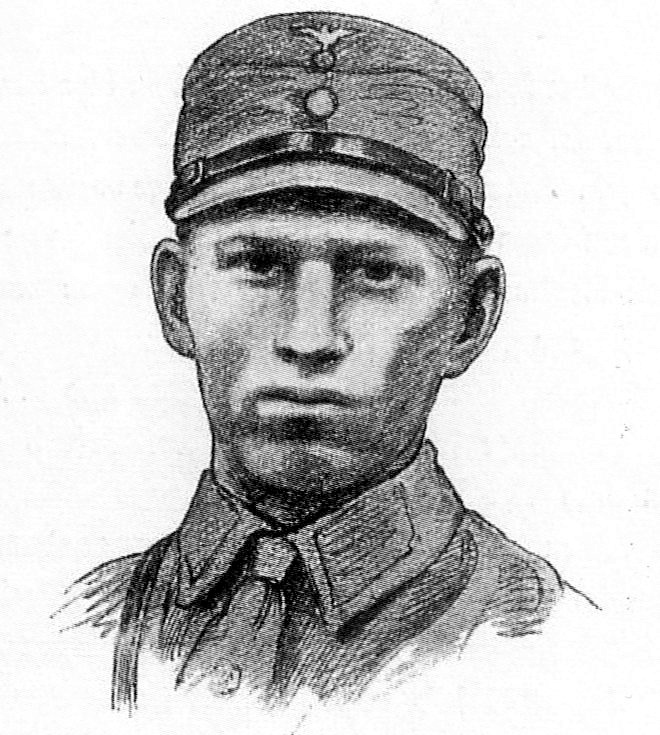
August Sievert was a resistance fighter against the Weimar Republic and a Blood martyr of the National Socialist movement.
On 30 June 1931, the SA man August Sievert, a confectioner from Brandenburg, was wounded by communists in street fighting in Peine with a shot to the stomach and succumbed to his injuries on 2 July 1931. His last words were:
„Germany awake!“
The local NSDAP group in Bad Grund in the Harz Mountains honoured his memory by giving his name to a newly built gymnasium in 1935. They issued an appeal for this, the words of which proclaim how the new Germany honours its heroes:
“A heroic deed will only fulfil its purpose if fellow human beings and the generations to come know how to appreciate it. This is what the history of the German people teaches us. The spirit of sacrifice that inspired our SA and gave it its irrepressible impetus, which culminated in the sacrificial death for an idea, is embodied throughout the Reich in the name of Horst Wessel and here in Bad Grund in the name of August Sievert, who went to his death with the words „Germany, wake up! This memorial should be erected to this spirit, as an eternal reminder to the following generations. And when, after a few years, a youth grows up here inspired by a true German spirit and physically healthy and sporty, then we can call out to our dead, whose spirit this hall was built in honour of, in the proud consciousness of fulfilling our duty: Your young blood, Kam’rad, has not flowed in vain!“
Karl Fiedler
(*1 September 1889, † 6 July 1931 in Krossen - a. d. Oder)
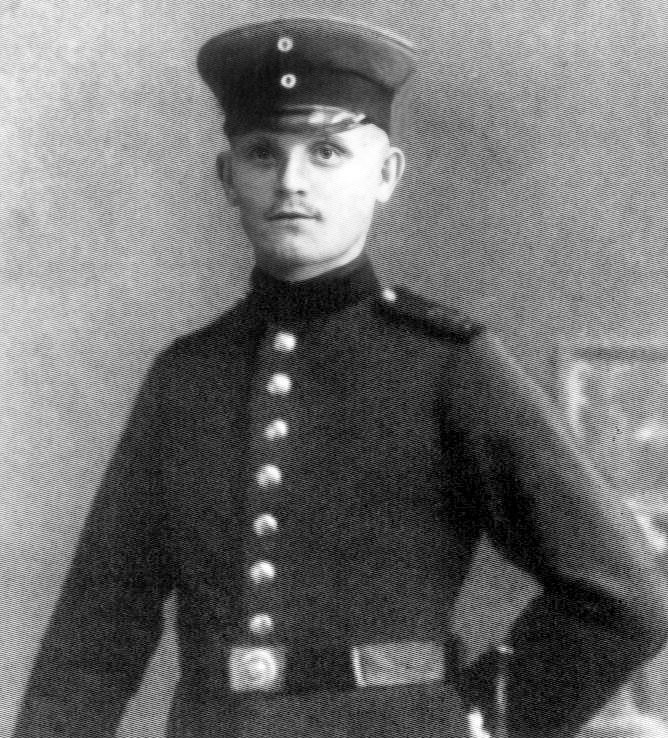
Karl Fiedler was a resistance fighter against the Weimar Republic and a Blood martyr of the National Socialist movement.
Karl Fiedler fought in the First World War against the superiority of the states that had declared war on the German Reich.
On 28 June 1931, the SA Scharführer Karl Fiedler, a transport worker from Krossen an der Oder, was seriously injured by the Stennes supporter Alfred Gützow after a political exchange of words and died of his wounds on 6 July 1931.
Hans Kersten
(*26 August 1912, † 18 July 1931 in Ünze (Brandenburg))

Hans Kersten was a resistance fighter against the Weimar Republic and a Blood martyr to the National Socialist movement.
The young agricultural worker and SA man Hans Kersten in Uenze in Brandenburg, an active party comrade who founded the local group Uenze of the NSDAP with four comrades, proudly and courageously wore his uniform, even though wearing it was forbidden. He did not allow his dress of honour to be taken from him. Communist bandits often ambushed him on his publicity expeditions in the surrounding area. He was able to defend himself manfully until he was attacked again by communists on 17 July 1931 and beaten down with a stake. The following day, Hans Kersten died in Perleberg hospital from the terrible injury.
Bruno Schaffrinski [Schaffrinsky]
(*15 September 1902, † 20 July 1931 in Pollwitten (East Prussia))
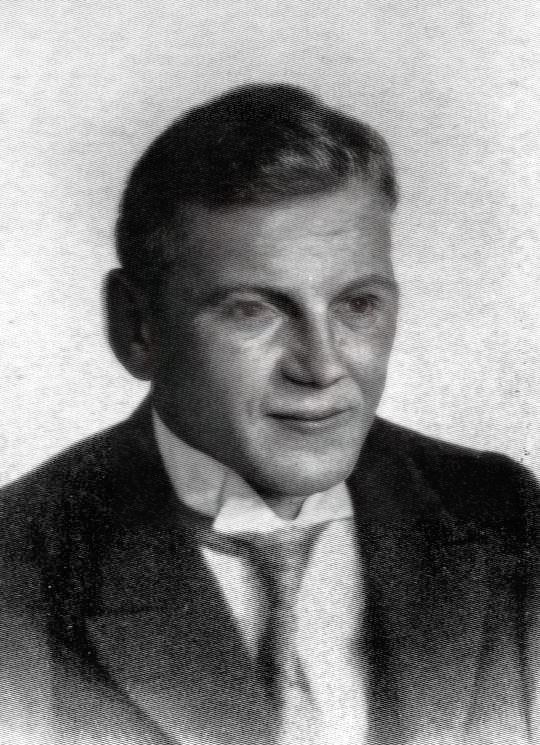
Bruno Schaffrinski [Schaffrinsky] was a resistance fighter against the Weimar Republic and a Blood martyr of the National Socialist movement.
Schaffrinski fought against the Polish occupiers in Upper Silesia at the age of sixteen.
His mother’s only breadwinner, the SA man Bruno Schaffrinsky in Cathrinhofen/East Prussia, who had also participated in the suppression of the Spartacist uprising in Königsberg, bled to death on 20 July 1931 after being shot in the artery. An amputation of the shot arm in the „Hospital of Mercy“ in Königsberg could not save his life.
Alfred Rühmling
(*26.1.1900 - † 2.8.1931)
1 August 1931 marked the seventeenth anniversary of the outbreak of the First World War in Germany. To mark the occasion, communist and pacifist groups demonstrated against war, armaments and the military in Wittstock an der Dosse in the German state of Brandenburg. Strong left-wing forces were gathered in the town of about eight thousand inhabitants.
The following evening, the National Socialists held a meeting in the Astoria Hotel. Afterwards, the men went to the storm restaurant „Zum Kronprinzen“.
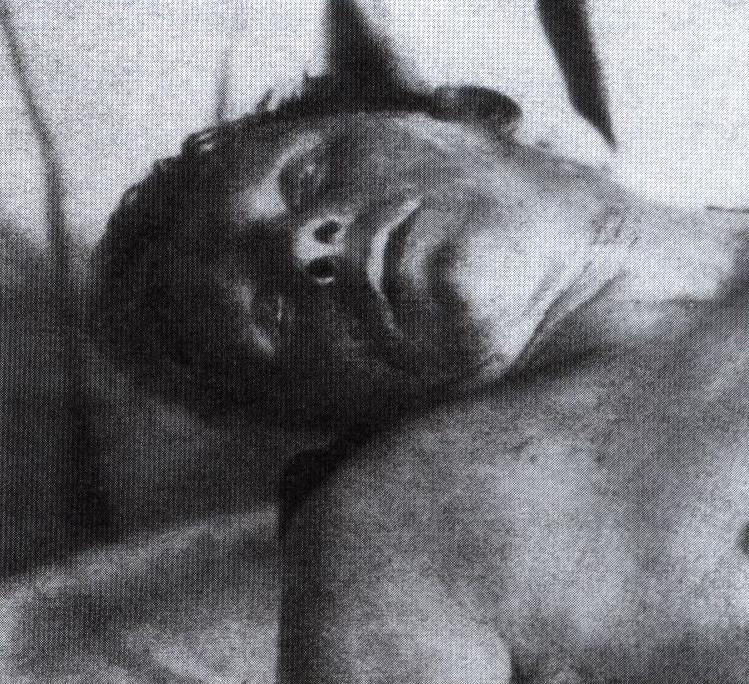
The body of Alfred Rühmling during the autopsy
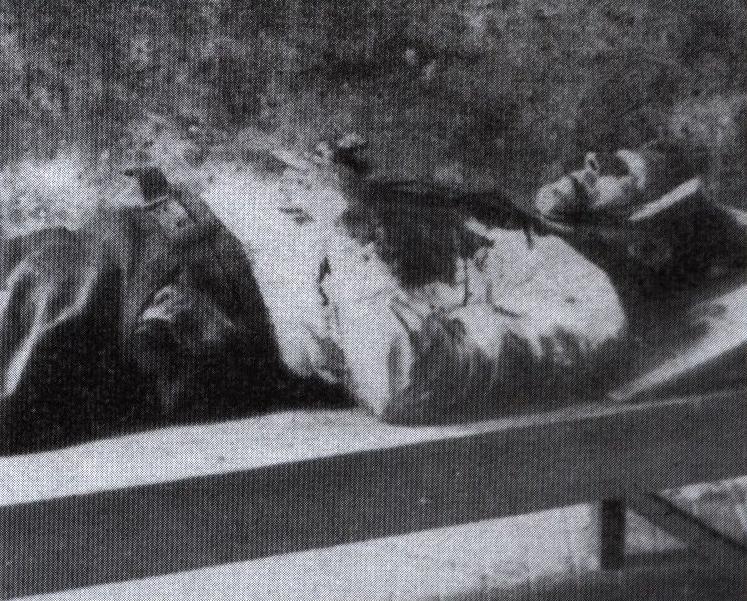
The dead SA man covered in blood shortly after the murder
Darkness has already fallen as more and more people gather in front of the restaurant. Insults and shouts of abuse reach the Brown Shirts from the street. A glance through the curtains tells the SA men what their opponents are doing. Women and adolescent girls stand at the front shouting to provoke the „National Socialists“. The men in the second row do not want to leave it at threats. They have knives, clubs and clubs in their hands.
Why it is precisely in this situation that the SA man Alfred Rühmling of Perleberg’s Sturm 11 steps outside the door with other comrades is unclear.
No sooner do the men show themselves in front of the pub, however, than several shots are fired. Hit in the chest, the father of four staggers a few metres and then collapses. While his SA comrades carry Rühmling into the inn, more shots are fired from the raging crowd.
Several people collapse injured by ricochets. The uninvolved Alfred Runzer receives an instantly fatal shot to the head.
The thirty-one-year-old fitter Rühmling dies on the table in the taproom.
A short time later, the communist Alfred Plötz was arrested as the perpetrator and sentenced to five and a half years in prison and three years of dishonour by the jury court in Neuruppin on 9 November 1931. Shortly afterwards, the Sturmabteilung buried its fallen communist in his home town of Lübeck.
Herbert Grobe
(25 April 1909 in Limbach (Saxony); 15 August 1931 in ibidem)

Herbert Grobe was a resistance fighter against the Weimar Republic and a Blood martyr to the National Socialist movement.
Herbert Grobe was born in Limbach, Saxony. He attended the local primary schools from 1915 to 1922. He then attended the Realschule in Chemnitz and from 1924 the Oberrealschule in Altenburg in the Erzgebirge. After graduating from high school, Grobe spent three years learning the trade of a merchant in his uncle’s fabric factory in Oberfrohna. At that time it was unusual for a young person from Germany to complete part of his education abroad. Grobe had the opportunity to go to the USA for a limited period of time in 1930 to work as a trainee after receiving a good school-leaving certificate. Even before he set sail, the twenty-year-old became a member of the SA and NSDAP in June 1929. After his return, the young man took up a job in his father’s small business in his hometown of Limbach. He looked into the world with open eyes and knew only one goal: to be a servant of the German movement. Both Herbert Grobe and his brother were known in the communist-dominated industrial town west of Chemnitz as active political recruiters for the NSDAP. For a long time, Limbach was the Marxist stronghold among Saxony’s industrial towns. The struggle of the few who rallied around the swastika banner was difficult. But they did not tire of the struggle, and more and more seduced supporters of the Red Front won them over to their ranks. In 1931, Herbert Grobe switched from the Sturmabteilung to the newly established SS in Chemnitz. Clashes between members of the NSDAP and political opponents were frequent in Saxony that year. It was therefore common to have well-known persons such as the National Socialist city councillors escorted home after meetings by SA or SS men. An eventful town council meeting took place in Limbach on 14 August 1931. Just as the systemic governments of the Reich and the Länder remained powerless and helpless in the morass of party bickering and parliamentary horse-trading, so it was on a small scale in the town councils. Among the crowds flooding the streets of Limbach were the men in brown shirts, and their words fruitfully promoted a new Third Reich. The result of the meeting was hours of serious rioting, with the workers’ militia leader Heinig from Limbach - future son-in-law of the KPD leader in Limbach, Bruno Granz - suffering injury. Heinig went to the Volkshaus, where the communists who had been summoned to carry out violent actions against the NSDAP were gathered. Bruno Granz was there ranting extraordinarily, accusing his comrades of cowardice for abandoning their leader. In connection with this, Jaros and Uhlig decided to kill a National Socialist that same night. Here the sources differ. One account states that the entire SS-Sturm 2/111/7, to which Grobe belonged, was arrested by the police and only released after midnight. Another account describes that the unit was first ordered to rest in the storm bar and then to go home for the night at around 1.00 am. SS man Herbert Grobe is on his way to his parents’ house shortly after midnight together with two of his comrades. The SA man Blume is the first to be dropped off at the flat door. In Hohensteiner Straße, SS man Müller says goodbye to his party comrade Grobe. Müller unlocks the garden gate and the front door. There he whirls around. Shots are fired. Shortly afterwards he hears the SS comrade’s cries for help. After a hundred metres he reaches the wounded comrade at a run. The squadron man wants to pursue the fleeing perpetrators, when several pistol shots whip towards him, but without hitting him. A hastily stopped car takes the two men to hospital. The doctors can no longer help the seriously injured. The SS man Herbert Grobe dies three quarters of an hour after the shots. The newspaper Der Angriff reported the heinous murder on its front page on 15 August 1931. The funeral procession passed through a line of brown shirts, the flags were lowered, thousands raised their hands in a final salute. There, out of the silence, no one knows from where, a woman’s voice sounds, resounds over the graves:
„Our sons will bring us back a united Germany!“
There is silence for a long time after this word. The German mother’s words echoed prophetically in the emotion of the hearts. One of the murderers was the blacksmith Paul Jahros, who hid with communist comrades in Leipzig and Berlin for several weeks after his deportation from Limbach. In Berlin he was issued a false passport in the name of Adalbert Aribert Grimmer from Göschen near Leipzig, duly stamped with a stamp from Leipzig police headquarters, so that Jahros could reach Moscow without inconvenience. Beforehand, he was given the ticket book to Moscow and a large sum of money, and in the cellar he was given a specific address to contact in Moscow. Jaros left Berlin on 8 January 1932 and arrived in Moscow on 10 January 1932. Jaros’ wife, who in the meantime had been assisted by Granz, was also taken to Russia in August 1932 at the instigation of KPD Limbach. In any case, this measure was considered necessary in order to prevent the wife’s thoughtless speeches from clarifying the case. Quite unexpectedly, Jahros and his wife returned to Limbach on 14 March 1933, certainly assuming that he would not be held responsible for the Grobe murder case. To the astonished question of his helpers and confidants why he had returned here when he knew what he had done, Jaros really did declare: „Died there or died here, it doesn’t matter.“ According to him, he felt that life in Russia was a great deception and, living conditions in Russia being the most unfavourable imaginable, he left Russia again despite the serious deed he had done in Germany. Jaros had initially made a partial confession to the criminal police about the murder of Herbert Grobe. At first he denied having been involved in the shooting, but this information was completely refuted by the testimony of his wife and the wife of Uhlig. Both women, completely independently of each other and without one having known what the other had already said, stated that their two husbands had jointly carried out the murder of Herbert Grobe. It should be particularly emphasised that in the circles which had been informed of the perpetrators, it had become known after the return of Jaros that the latter had said that he now wanted to betray the case. For this reason, the confidants had a meeting in the flat of one of them on Monday, 6th 1933, and there, after recalling the case, they decided to tell the pure truth if they were arrested. True to their intentions, they then gave their testimony to the criminal investigation department completely voluntarily, whereby it should be emphasised that their statements turned out to be correct upon examination. The conviction of the second perpetrator, the ironworker Willig Uhlig, failed at first mainly because his wife smuggled reports into the prison and took them out again. The following report was published by the criminal investigation department:
In the night of 15 August 1931, the SS man Herbert Grobe from Limbach was shot dead and an attempt was made on the life of the SS man Walter Müller. According to the unimpeachable findings of the time, there were two perpetrators, both of whom fired, which could be deduced from the fact that the casings of two different pistols were found. At that time, the ironworker Willig Uhlig, born in 1891, was already taken into custody as a suspect of the crime. The investigations conducted against Uhlig by the public prosecutor’s office in Chemnitz had to be discontinued due to lack of evidence and Uhlig was released.
The arrest on 9 and 10 March 1933 made it possible to fully investigate the Grobe murder case. The already mentioned Uhlig and the blacksmith Paul Jaros, born on 21 September 1905 in Lüben (district of Liegnitz) and living in Limbach, Peniger Str. 7, who could be arrested in Limbach, were identified as the perpetrators. Uhlig disappeared without a trace from Limbach on 8 March 1933.
The wives of the two perpetrators were also arrested, who, as confidants, did not fulfil their obligation to report the crime, as well as two other confidants.
After the flawless confession of the confidants and the women before the criminal police in Limbach, to whom the entire validity was transferred, the perpetration of the murder of the SS man Herbert Grobe by Uhlig and Jaros has been proven without a shadow of a doubt.
The National Socialist movement honours their deceased with the honorary name „Herbert Grobe“, awarded to SS-Sturm 4/84 and Abteilung 8/321 of the Reich Labour Service. In Limbach-Oberfrohna, on 26 June 1937, on the occasion of the 25th anniversary of the local school, a memorial plaque was unveiled for the fallen of the First World War and the Blood martyr Herbert Grobe. The memorial consisted of a wooden plaque with the names. Above the plaque was a banner commemorating Herbert Grobe. In the middle of the banner was the German eagle above the swastika ring. Two oak leaves grew out of the banner, on which was the date of Herbert Grobe’s death. Below the memorial were two stone hooks, from each of which hung a golden wreath of honour. Below the plaque was a stone bench with the dates 1912 and 1937. The inscription read, in addition to the names of the war dead:
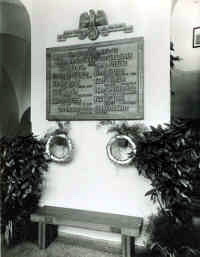
Herbert Grobe † 15.08.1931 for the Third Reich
Hans Hoffmann
(13 February 1913, 17 August 1931 in Berlin)
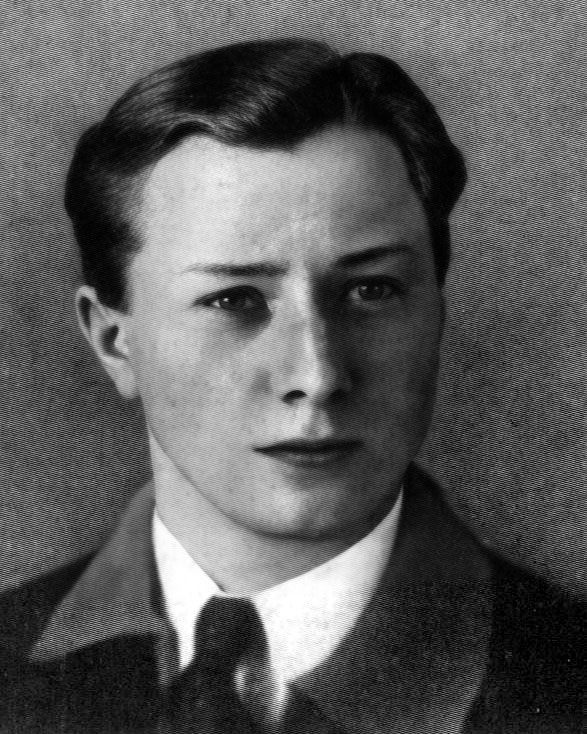
Hans Hoffmann was a resistance fighter against the Weimar Republic and a Blood martyr to the National Socialist movement.
It is 21 July 1931. Hitler Youth Hans Hoffmann limps on sticks to his comrades at Lausitzer Platz in Berlin. Duty calls him, who is still suffering the consequences of a motorbike accident and has not yet fully recovered from a compound fracture of the leg. His mother, who doesn’t want to let him go because the communist mob knows the boy and is chasing him, hurries after him, foreboding disaster. She finds him and implores him to come home with her. He follows her together with a comrade. There they meet a familiar woman and greet her. The boys remain standing while the mother exchanges a few words with the woman, turning her back on them. Suddenly the woman cries out: „Mrs Hoffmann, they’re beating Hans!“ That is the beginning of the terrible event. Three young boys attack the almost defenceless Hans Hoffmann and his friend and beat them. The mother intervenes and wants to pull the boys away. But it is already too late. Another pack approaches, ten or fifteen dark figures. Where to put the boy? A shop door seems to bring salvation. Frau Hoffmann rushes towards it, but the boy on the sticks can’t go that fast. Meanwhile, a strange woman jumps in, slams the shop door and locks it from the inside. A shout at the back of the fleeing men: „Watch out, make way!“, and two shots are fired in quick succession from the pursuing group. Hans Hoffmann, hit in the body, turns around and collapses. The mother catches him herself and cannot even prevent a third shot from hitting him in the back. Then the mob flees. This is the event of the cowardly communist attack on the Hitler boy Hans Hoffmann at Lausitzer Platz. He lies in hospital for twenty-seven days, hovering between death and life. Among the numerous greetings he receives from his fellow fighters is a personal letter from Dr Goebbels. On 17 August 1931, Hans Hoffmann dies at the age of seventeen. The murderer, the communist Käßling, is sentenced to six years in juvenile prison by the Weimar system justice.
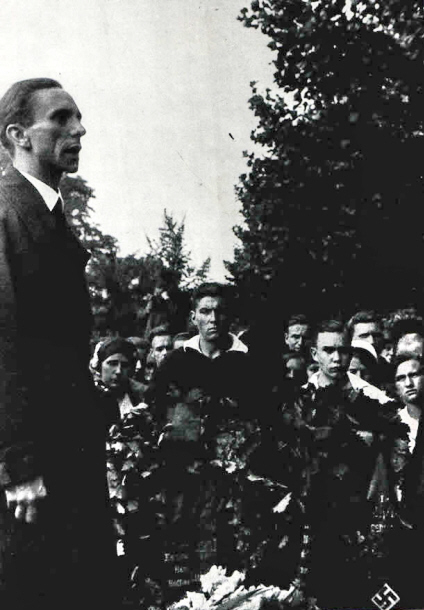
The conqueror of Berlin, Dr Josef Goebbels, at the grave of Hitler’s boy Hans Hoffmann,
Berlin, killed 17 August 1931
He was buried in the garrison cemetery. A gravestone with the HJ tradition badge adorns the grave. In honour of Hans Hoffmann, a memorial plaque was unveiled at Lausitzer Platz during the Third Reich:
Here fell
at the hands of communist murderers
17 August 1931
the Hitler Youth Hans Hoffmann
for Germany and his Führer.
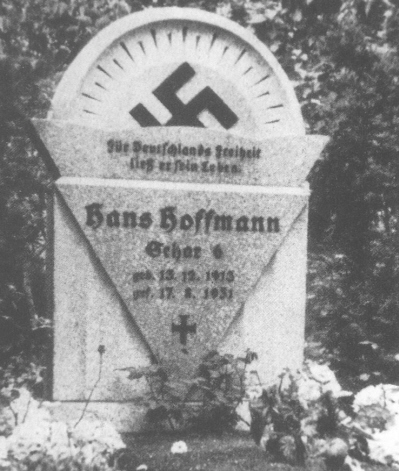
The name „Hans Hoffmann“ was added to the list of the Immortal Followers of the Hitler Youth.
Johannes [Hans] Mallon
(*30 June 1914 - † 3 September 1931 in Bergen a. Rügen)
District Pomerania
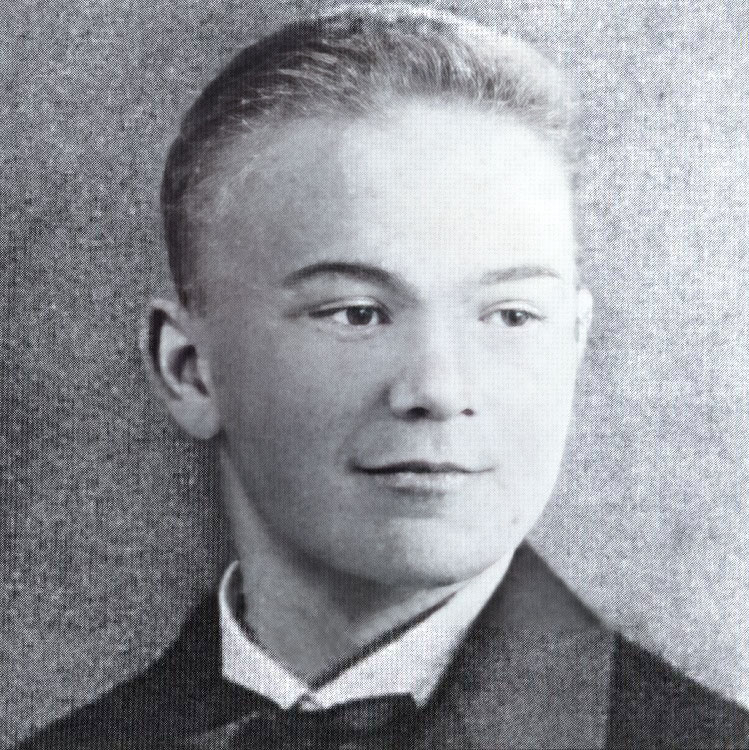
Johannes [Hans] Mallon was a resistance fighter against the Weimar Republic and a Blood martyr of the National Socialist movement.
„Many a one who last time boldly leapt through the embers, lies on the bier, bloody and sallow, died from the assassin’s assassinating steel that pierced his breast.“
The fire speech of the poet Heinrich Anacker, read on 21. 6. 1931 on the Baltic Sea island of Rügen, was an unconscious, uncanny announcement of what was to happen in the course of the night.
Due to its agricultural character, Pomerania was basically an area without any political conflicts worth mentioning. The Greifswald Bloody Sunday on 17 July 1932, in which three SA men died, was an exception. However, the workforce of the chalk works on Rügen produced various left-wing groups.
Until 1931, the Rügen Hitler Youth had held all the marches and festivals of the year in the NSDAP association. This year, with the summer solstice, an independent celebration was to take place for the first time. Some of the Hitler Youth from the greater Bergen district were driven to the event by lorry. According to the old custom, the boys and girls marched in the light of the torches to the woodpile, which was ceremoniously lit. With fire speeches, folk dancing and the songs of the Hitler Youth, the celebration of the shortest night of the year took its course. The boys and girls jumped over the fire and the flames burst into flames once again as the last torches flew into the embers.
In closed formation, the Hitler Youth set off again in the direction of Bergen. The path led through a hollow way, at the edge of which the political opponents had hidden, as Gertrud Herr, the later leader of the BDM in the Pomeranian Gau, reports. A hail of stones suddenly pelted the column. In the darkness of the summer night, it was difficult for the attackers to make out a clear target. The flag, however, towered above the heads of the group, clearly visible even in the darkness. It became the preferred target of the stone throwers. Mallon, who had been chosen by his comrades to carry the flag, was hit in the back of the head and collapsed bleeding.
Three days after the assault, the seventeen-year-old was initially able to resume his work. However, he complained constantly of headaches. On the eve of his death, the complaints became so bad that the boy could no longer hold himself upright. He died at 8.00 a.m. on the morning of 3 September. Rügener Hitlerjugend hold guard of honour at the open coffin of their comrade Hans Mallon. of a previously undetected cerebral haemorrhage.
Hans Mallon was born on 30 June 1914 in Bromberg, West Prussia. After the First World War, the family moved from the now Polish-occupied city to the island of Rügen. His war-disabled father died in 1930, and the boy had to leave the Ernst Moritz Arndt Secondary School in Bergen on Rügen for economic reasons. He then entered an apprenticeship at the Rügen Electricity Works. The blond and tall boy will not have had an easy time there because of his openly National Socialist attitude. He had been a member of the NS-Schülcrbund since 1929, from which he transferred to the Hitler Youth in 1930.
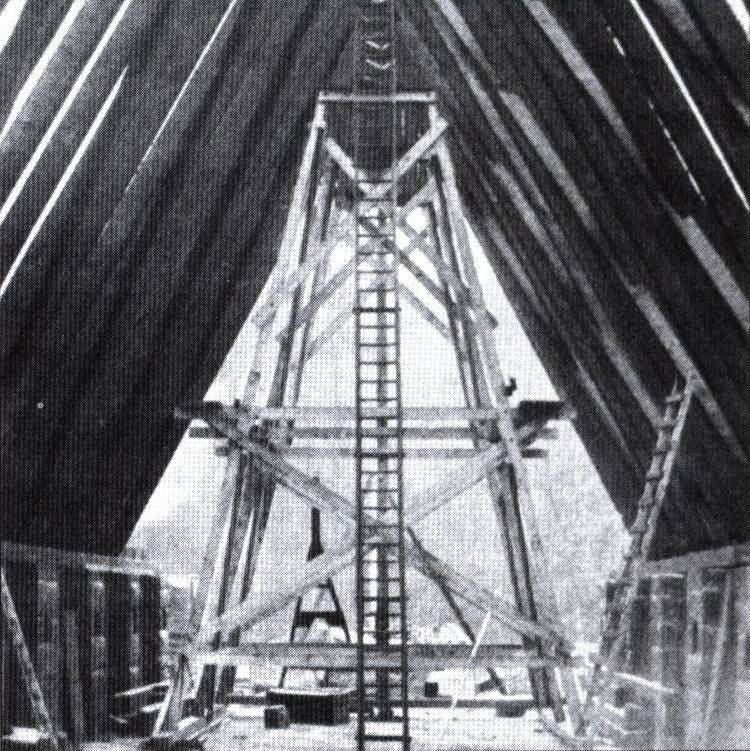
Hans Mallon House in the construction phase
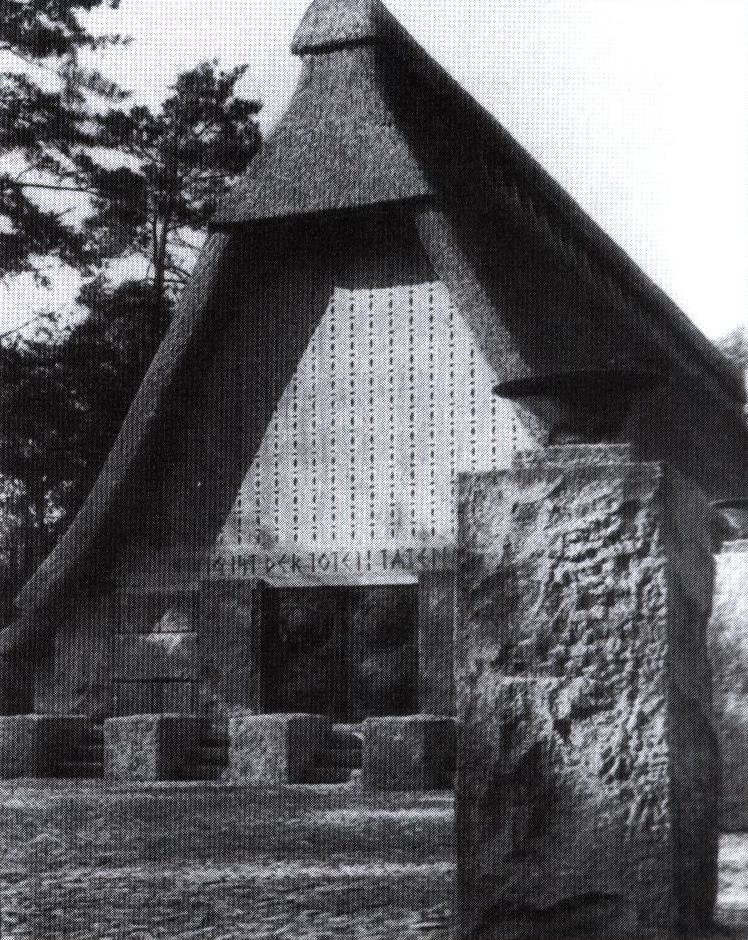
Hans Mallon House on Rügen
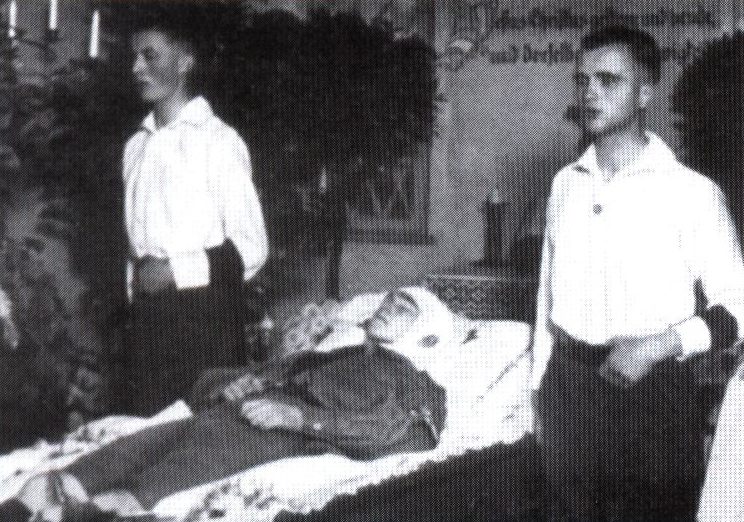
Rügen Hitler Youth hold guard of honour at the open coffin of their comrade Hans Mallon.
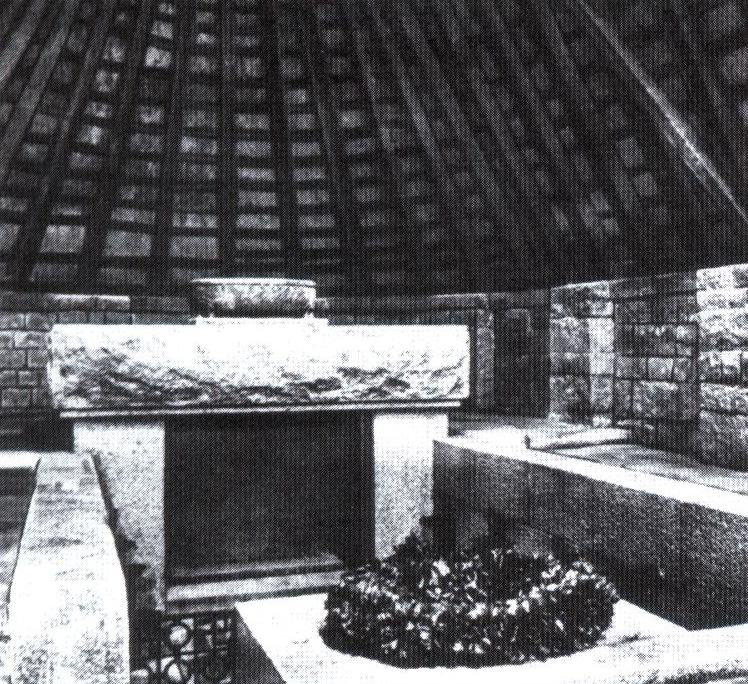
The grave in the Hans Mallon House
Gefolgschaft 1 of the Rügen Hitler Youth later bore the name of the dead man.
The „Völkischer Beobachter“ reported on the funeral ceremonies in the usual style of the time:
„Johannes Mallon, your comrades shout ‘Here’ for you at the roll call of Our Murdered Hitler Youth Mallon’s last journey, Bergen on Rügen, 10 September. On 22 July, the Bergen Hitler Youth reported: Yesterday, while marching to the solstice celebrations, we were attacked by communists and pelted with a hail of stones. The pennant bearer Hans Mallon was hit in the head by a stone and had to seek medical treatment.1 Today we have buried him, another one of our best. - The sky is dreary and grey, the wind whistles coldly over the island of Rügen, it is as if nature wants to mourn with us. The small town of Bergen is also marked by this sign. Almost the entire population has moved out to the cemetery. In front of the hall, surrounded by black, are the flags of the Hitler Youth and the storm flags of the Rügefischen SA. Inside, a German mother - her husband died a year ago - says goodbye to the only thing she has left, her boy. For the last time, his leaders shake his hand: „Farewell comrade, as you lie there, in the brown costume of the Hitler Youth, as we have often fought side by side for Germany. Hard farewells and the hammer blows pound into us, you did not die in vain, we will know how to avenge you one day. Then they carry him out, four Hitler Youth and four comrades of the SA. The coffin is covered with the flag of the HJ, and now they escort him to his final resting place. A German pastor speaks.
No one has greater love than those who lay down their lives for their friends.-Pg. Fischer brings the greetings of the Gauleitung of the Party. Then Karl Rentzel, the leader of the Pomeranian Hitler Youth, spoke. Thank you, comrade, you will lead us forward, you will be an example for us. The homeland will remain loyal to you, because in the future, Gefolgschaft I, Rügen, will bear your name, and when your local group leader calls out the names of the members, your comrades will call out ‘Here’ for you, you will always be among us. And when the name ‘Hans Mallon’ resounds over the grave, a many-voiced ‘Here’ roars back from where the Hitler Youth stands. Horst Wessel’s song, the flags are lowered for the last salute, and with the song of the good comrade they all say goodbye to him. Now it’s time to move forward over graves, and with a clear view and a firm step we move back towards Bergen, towards a new battle and with it towards our final goal, the ‘Third Reich’.“ Mallon was not the first Hitler Youth to pay with his life for the struggle for political power in Germany, and he was not to be the last.
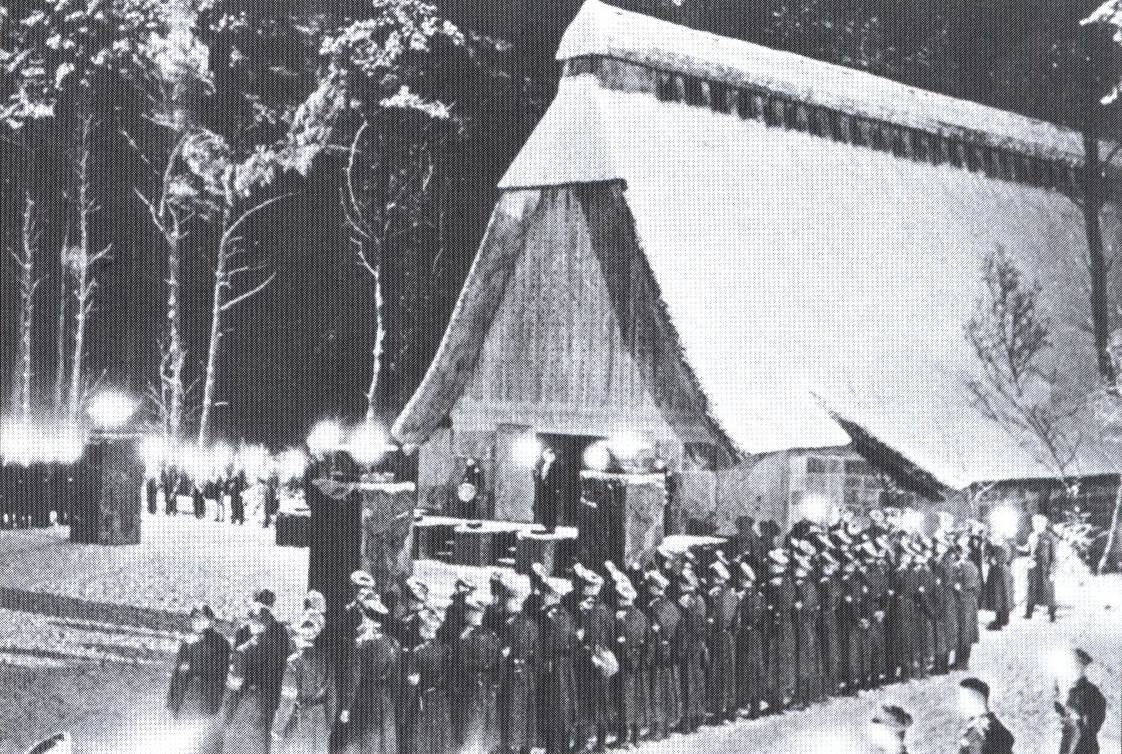
Hitler Youth in front of the nocturnal backdrop of the Hans Mallon House on the island of Rügen
An impressive memorial was built on the spot where Mallon last saw the flames of the solstice fire blaze. The German War Graves Commission erected a memorial hall between 1935 and 1937. The architecture of the building was based on a Germanic longhouse. A single hall was covered by a towering gable. The roof beams of larch trunks, visible from the inside, rested on a masonry of large granite blocks. The forecourt was used by the Hitler Youth for celebrations and had four large pillars on which fire bowls were mounted. The hall must have had an impressive effect both because of its historical construction and because of the interior, which visitors entered through a large bronze gate decorated with swastikas. The Edda words „Ewig ist der Toten Tatenruhm“ (Eternal is the glory of the dead) were carved into the wood above the entrance and coloured with ox blood. The body of Hitler’s boy rested in a tomb covered with green porphyry slabs. The battlefields of the First World War were marked on them.
Spatially, the structure was connected to an already existing but much smaller memorial to the fallen. The monument was the starting point for the Pomeranian Hitler Youth to march towards the Reich Party Congress in Nuremberg and is shown in the film „The March to the Führer“. In 1945, the Hans Mallon House became the last repository for the East German Hitler Youth flags. To save them from desecration by the Red Army, a Hitler Youth leader set fire to the thatched building shortly before the Soviets invaded. The importance and familiarity of the name Mallon even after the end of the war becomes clear when a namesake of the deceased reports that he, with his entire family, had been driven out of East Prussia to Western Pomerania and had been imprisoned by the Russians only because of the similarity of the name.
Raddasstraße in Bergen was renamed Hans-Mallon-Straße during the National Socialist era. In GDR times it was called Strasse der Jugend. It is currently called Raddasstraße again.
Karl Vobis
(*16 January 1899, † 4 September 1931 in Düsseldorf)

Karl Vobis was a resistance fighter against the Weimar Republic and a Blood martyr of the National Socialist movement.
Karl Vobis was an SS man by choice, he was a carpenter from Düsseldorf. As a war volunteer, he went into the field at the age of eighteen against the states that had declared war on Germany. He was wounded twice, received the Iron Cross, fell into French captivity, from which he did not return until 1920. He immediately rejoined the ranks of the national fighters, and when there was a particularly dangerous assignment in the SS service, Karl Vobis always volunteered. On 3 September 1931, on his way home from a meeting in Derendorf, he was attacked and stabbed to death by communists; he died the following day. The murderer was sentenced to three years in prison by the Weimar system of justice.
Sturm Düsseldorf bore his name of honour.
Hermann Thielsch
(*30 January 1911, † 9 September 1931 in Berlin)
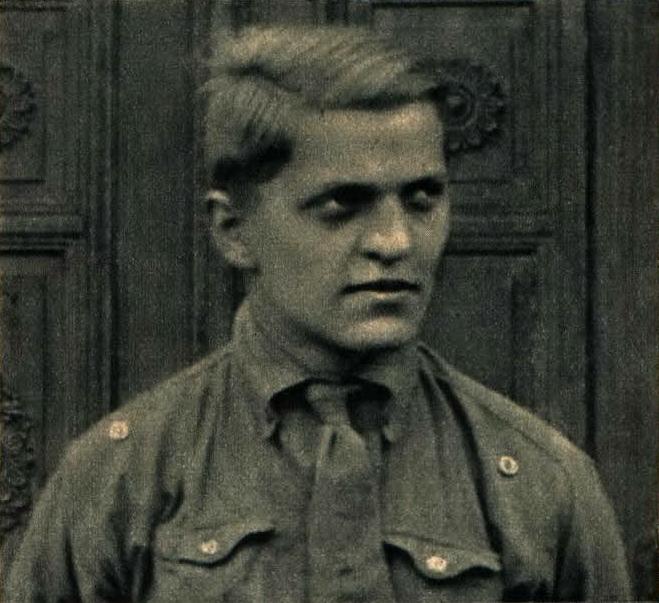
Hermann Thielsch was a resistance fighter against the Weimar Republic and a Blood martyr of the National Socialist movement.
In front of the SA pub, on the corner of Gneisenaustraße and Solmsstraße, stood the guard, four of them watching over the safety of their comrades. This was necessary here in one of the strongholds of red Berlin, more than anywhere else. It was 9 September 1931, the year when in the capital of the Reich, SA-man meant being fair game. Four burly, defiant guys, they stand there in the service of their leader. One of them is Hermann Thielsch, who earns his living as a car mechanic, the sole breadwinner of the family. The work is hard and makes you tired. But there is no such thing as being tired for SA service. And they all think like him. He and his comrades are on guard duty in front of the Berlin storm bar „Zur Hochburg“. Shots whip out of the darkness. Four fighters for Germany are torn apart by the bullets. Hermann Thielsch, shot through the head and body, dies with the words:
„Hail Germany“
At his grave, the mother cries. A hand reaches out to her. Out of tears she looks up, looks into the eyes of that man of whom her boy often spoke, enthusiastic and adoring. And sees reflected in those eyes her own pain and suffering and realises why she had to make a mother’s supreme sacrifice. After a few days, she writes to Dr Joseph Goebbels:
„Dear Doctor! A deeply bent mother would like to thank you for all the kindness and participation that you and your co-workers, functionaries, etc. have shown and demonstrated to her and her relatives in such a tender and sensitive way during the days of pain.
Unfortunately, it is impossible for me to personally thank all the good and faithful multitudes who have taken care of me in my misfortune, protected me, comforted me and raised me up, if only because they have for the most part remained unknown to me. And therefore, dear, good doctor, I ask you most sincerely to convey this thanks of mine, which would squeeze me if I could not get rid of it, to all those who have a right to it.
I know that National Socialist people do not ask for thanks, but I do ask to be allowed to thank you in the way that seems appropriate to you. It is my heart’s desire, and I would feel ungrateful if I did not make this request.
If anything can bring me over the deep pain of the loss of my only, much-loved, blond boy, it is the deep sorrow of the SA. and SS. comrades, the sincere sympathy of the party comrades and the many tributes that are to keep the memory of the dear dead man sacred. And for this, dear, esteemed doctor, I thank you once again from the bottom of my heart.
In deepest veneration and gratitude I am and will always remain your devoted Lucie Thielsch, on behalf of her relatives.“
The newspaper Der Angriff wrote about the events:
With the victims of the red murderous agitators
At the bed of grief of comrade Carl Seelig - At the grave of Hermann Thielsch:
[...] On Friday of last week we laid to rest comrade Thielsch, who had to give up his young life under the cowardly murderous hand of the communists. We carried him to his grave like a prince. A nation mourned with its parents, with its comrades. A mountain of flowers piled up above the burial mound. Four of his comrades still keep the wake. The faces of the men guarding the tomb of the dead are brazen. Party comrades and comrades who visit the grave come and go uninterruptedly. Silently they stand around the mountain of wilting flowers. Every loud word is stifled. The wind shakes drops from the rain-soaked autumn leaves of the trees. The countless wreath ribbons with black swastikas glow bright red. Outside, beyond the walls that surround this quiet square, life pulsates. Outside, they fight for their daily bread. Outside, irresponsible criminals incite the red subhumanity to new acts of murder. Perhaps right now, as we stand here at the fresh grave of a comrade, somewhere in the stone shafts of Berlin, a new victim is falling under the knife of communist murderers. We take leave of the grave of the dead and want to carry the spirit of that fallen man to the masses. Hermann Thielsch did not fall in vain. His death brings thousands and thousands to us. More and more crowds are streaming past us to the grave. They come from all parts of the city. Only a few of them knew Thielsch. But nevertheless they all know him! He is the unknown SA. man. All the mothers whose boys are also in the army of these unknown fighters make a pilgrimage to the grave of this man who died for them all. Tomorrow it may be their own son. Many mothers weep for this dead man.[1]
Adolf Hitler in the cemetery
The Führer remembers his dead comrades
This morning shortly after 10 o’clock, Adolf Hitler accompanied by Dr. Goebbels went to the Luisenstädt cemetery in Bergmannstraße, where we had to bury many of our fallen comrades. The Führer visited the various graves and lingered in silent remembrance before the garlanded mounds. At Hermann Thielsch’s grave, Adolf Hitler laid a wreath of laurel and fir green. On the black ribbon were the words:
„My dead comrades! Adolf Hitler.“
It was a quiet and moving hour in the cemetery. Amidst the budding bushes, our thoughts went back to the days when we had to bury our slaughtered comrades here behind muffled drums. It was through their sacrifices that today was won. In grateful comradeship, the Führer now stood at their graves, united with them beyond death.
They died so that Germany might live.
In Berlin, a shawm band bore the honorary name „Hermann Thielsch“.
Gerhard Wittenburg
(*6.6.1913 - † 17.9.1931)
District Mecklenburg
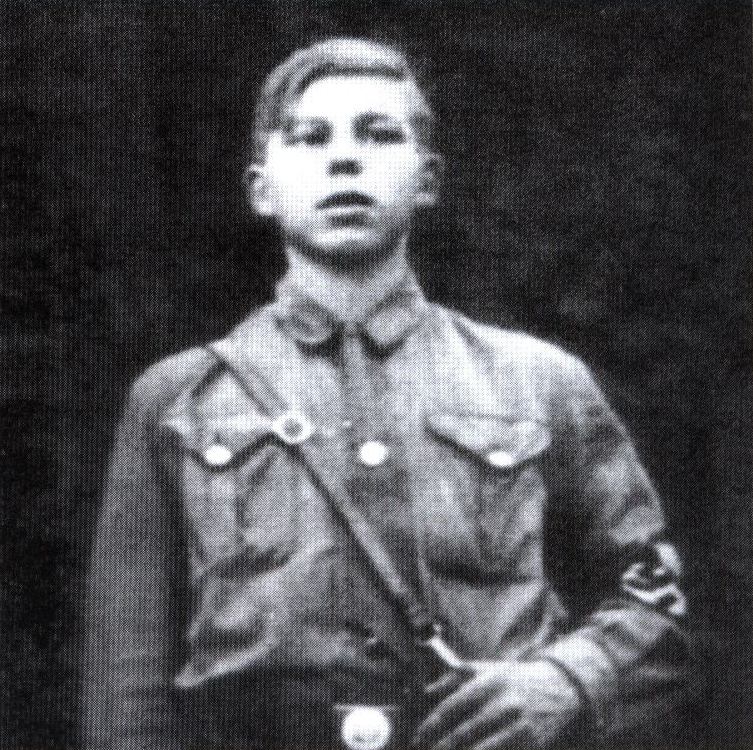
In its September 1931 issue, the magazine „Der junge Sturmtrupp“ quoted the later Reich Youth Leader Artur Axmann:
„We do not believe in your fabulous International. Have the foreign workers’ organisations ever made any effective protest about the tremendous tribute burden resting on the shoulders of the German worker? Until the last Bantuneger has come to the realisation that the German worker must be helped, we will not wait! We do not believe in others, we believe in our own strength!“
The police assessed the death of the Hitler Youth and SA man Gerhard Wittenburg, from Zarrentin in Mecklenburg, as a traffic accident with an unexplained background.
The NSDAP also knew that the exact circumstances of his death could not be determined. This is the reason why the name Gerhard Wittenburg is not mentioned in various NSDAP lists as a Blood martyr of the movement. Nevertheless, the SA-Sturm 54/89, Zarrentin and the HJ-Gefolg- schaft VII, Gau Mecklenburg listed the name of the dead man.
Wittenburg was born in Schmölln, Thuringia. The boy’s father was a railway official, but had to give up the profession because of alcohol abuse. The mother then divorced him and supported Gerhard and his brother alone with modest means. Before the eighteen-year-old moved to Mecklenburg, he was already active for the NSDAP in his homeland. In Zarrentin, Wittenburg worked at the Mühlenfeld nursery, which was run by the local group leader. The gardener’s apprentice quickly became his right-hand man and an important support for the political work of the local group. Thus, in addition to his SA service in Sturm 54, he also took on the leadership of the HJ-Gefolgschaft Vll. Apart from the praise of his comrades, however, his activity also brought him the attention of his political opponents. In August 1931, the young SA man distributed leaflets attacking the high salaries of Weimar politicians. As there was no legal authorisation for these handbills, Gerhard Wittenburg was sentenced to a fine of 10 Reichsmarks by the Hagenow district court. The local group treasury was prepared to pay the fine. Nevertheless, the SA man wanted to discuss the matter with the district leader Braune. After Wittenburg had set off on his bicycle to the district leadership on 17 September, as he had done so often before, he was found at about 7.30 p.m. between Zarrentin and Wittenburg near the Schaalmühle mill with a gaping head wound. Gerhard Wittenburg died later that evening in Hagenow hospital as a result of a fractured skull.
Sources close to the NSDAP reported that a doctor had determined that the head injury of the eighteen-year-old was not caused by a fall, but by violence.
Gustav Seidlitz [Seydlitz]
(* 26 July 1906, † 20 September 1931 in Meseritz)
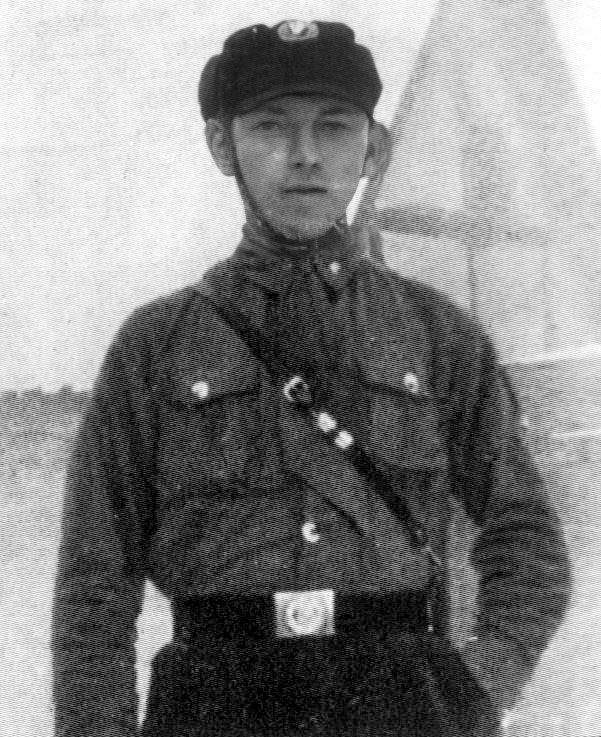
Gustav Seidlitz [Seydlitz] was a resistance fighter against the Weimar Republic and a Blood martyr of the National Socialist movement.
On 20 September 1931, on the return journey from a trip to the Ostmarken, food was taken at 7 o’clock in the evening at the Birkenhauer restaurant in Meseritz. SA men who had stayed behind were attacked by communists near the restaurant. Communists gathered in front of the restaurant, chanting with hatred, and tried to storm the restaurant. The SA Scharführer Gustav Seidlitz, a worker from Schwiebus, was shot twice. The murder was not fully investigated until 1933.
A few weeks earlier, he had hung up the slogan in his SA home:
„Germany will live even if we die.“
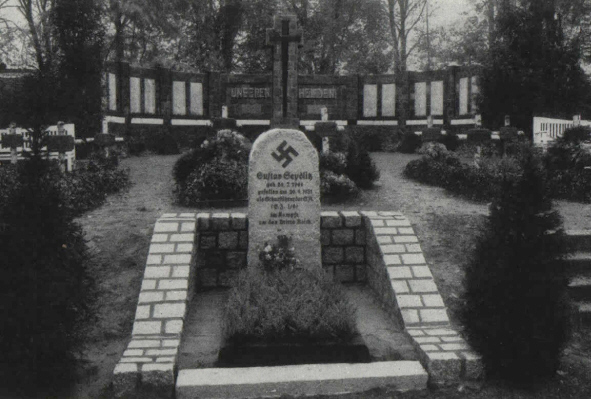
The resting place of Gustav Seidlitz, Messeritz,
Fallen on 20 September 1931
In Schwiebus, Seydlitzstrasse was named after him.
Erich Garthe
(*29 January 1901, † 6 October 1931 in Essen)

Erich Garthe was a resistance fighter against the Weimar Republic and a Blood martyr to the National Socialist movement.
On 5 October 1931, the SS man Erich Garthe, a thirty-year-old merchant from Essen, was on his way home from the troops’ roll call with his comrade Klihm. They were chased by 20-25 communists and pelted with stones. Erich Garthe was leading his comrade to his flat when two shots rang out from the darkness, knocking him to the ground. The murderers rushed over the defenceless man bleeding to death and fired three more shots at him. „Take the carrion’s boots off!“ commanded the leader of the communist murder gang.
The last words Erich Garthe said to his comrade were:
„For Adolf Hitler I give my life“.
Kurt Nowack
(*16 September 1911, † 11 October 1931 in Berlin)
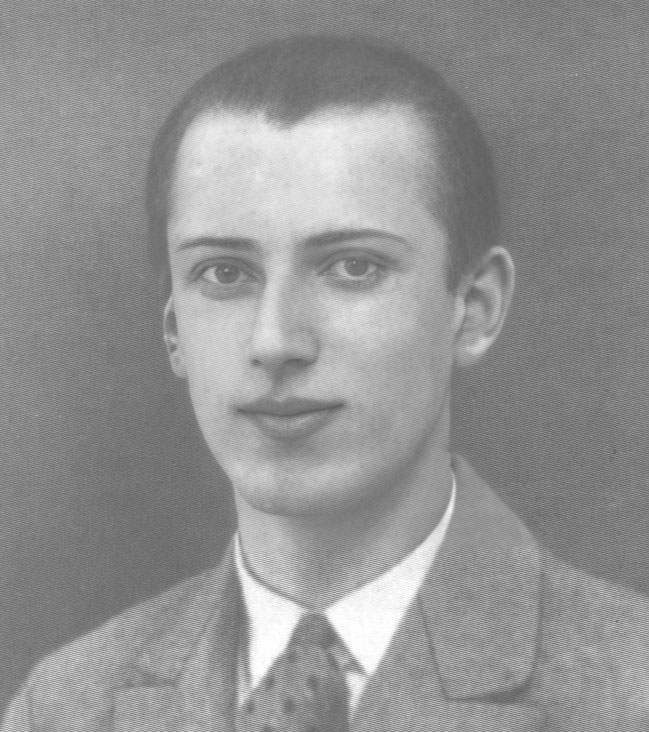
Kurt Nowack was a resistance fighter against the Weimar Republic and a Blood martyr to the National Socialist movement.
At Horst Wessel’s bier, the men of Sturm 5 held the guard of honour. One of them was the SA man Kurt Nowack, a young postal worker from Berlin. His heart was filled with deep sorrow for the fallen Sturmführer; the great dead man was a role model for him. He was the first member of his family to join the SA. His brother followed him. The whole family in Berlin’s Weidenweg was then considered „National Socialists“. Even the mother had to put up with abuse because of her sons’ party affiliation.
When Kurt Nowack accompanied two SA comrades home on 11 October 1931, the small group was shot at by communists. Five bullets hit him, one penetrated the heart. The murderer was acquitted by the court and then fled to Soviet Bolshevik Russia.
The commune in red Berlin-Lichtenberg even disturbed the funeral service with hateful chants, at which Dr. Goebbels was also present.
The SA group leader Ernst gave the eulogy:
„His death was a holy seed, cast on holy soil. It sprang up for harvest, for the mighty awakening of the nation. It sank into the dust so that our people might rise from the dust.“
A memorial plaque was placed at the site of the murder after the victory of the National Socialist revolution:
On this spot, on 11. 10. 1931, the
the SA man Kurt Nowack
murdered by communists.
Germany must live, even if we have to die.
Heinrich Böwe
(*22 June 1882, † 19 October 1931 in Berlin)
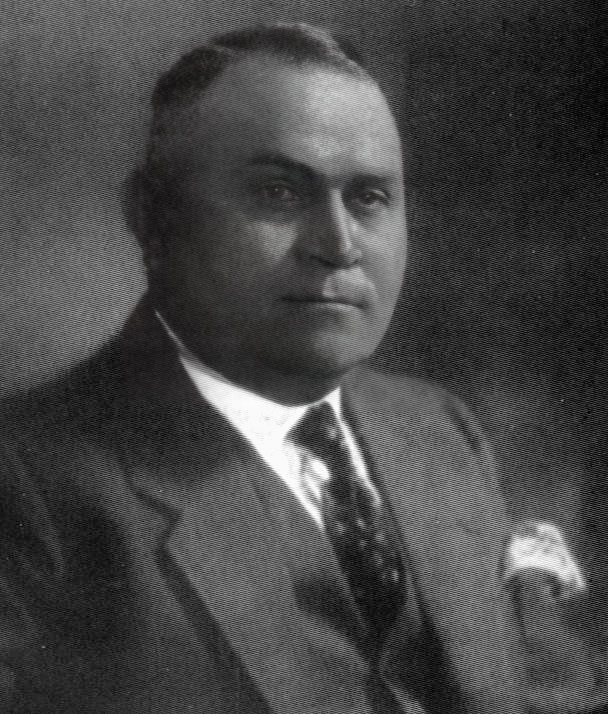
Heinrich Böwe was a resistance fighter against the Weimar Republic and a Blood martyr to the National Socialist movement.
In September, they laid Hermann Thielsch to rest. On 15 October 1931, Sturm 21 held a memorial service for him in Berlin-Neukölln. In the traffic pub, in the Richardsburg, where Thielsch spent many hours with some comrades, they now stand with raised arms and commemorate their dead friend. The song of the good comrade fades away. Silence - then it whips through the windows - communist attack. The landlord of the pub, the architect and party comrade Heinrich Böwe, asks his wife and daughter to take cover. He is hit in the head by a ricochet. A few days later, the severe injury kills him. His son-in-law Matschat, the squad leader Vorbereiter and the SA man Sawetzki were also seriously wounded in the attack. Two Schupo officers patrolled in front of the pub. When the communists approached, they fled without resisting them, without warning the unsuspecting people who had been attacked. The police who were called arrived considerably late. The communist murderers escaped to Soviet Bolshevik Russia with the support of the Red Aid.
The Gauleiter Dr Goebbels visited the crime scene a little later.
The newspaper Der Angriff wrote about the events:
We lower the flags and swear ...
At the grave of comrade Böwe:
On Saturday we buried another comrade. The innkeeper Pg. Böwe was laid to rest. It was barely four weeks ago that we stood on the same spot, at that time it was comrade Hermann Thielsch whom we paid our last respects to. The sky is grey. It drips from the bare trees. Between the graves, up the path from the mortuary to the open grave that is to receive the earthly shell of the dearly departed, they stand close together. Men and women, party comrades, comrades of the murdered man. They wait with hard faces to call out a last greeting to the dead. The muffled sound of drums. The funeral procession approaches at a measured pace. The faces of the SA. men who carry the coffin to its eternal rest are rigid and pale. A swastika flag covers the funeral shrine. Silently, the men and women along the way raise their hands in final salute. Drums rattle muffledly. The coffin slides into the pit. The flags are lowered. The priest speaks harsh, masculine words over the open grave, he too was once a soldier, a fighter, the Iron Cross shines on his black gown. Next to the grave stand the wife and daughter of the man whom communist murderers shot from ambush because he was a German. There stand the two women from whom nefarious murderers have taken the breadwinner, more than the breadwinner, the husband and the father they have murdered. Millions of hearts feel for the two women bent by grief. Out of millions of hearts the vow rings out, we will not leave you! Not for one hour will we forget those who did this to you! We stand and remain silent, we need not say any more that we will not forget. Dr. Goebbels approaches the open grave. In brief words, glowing with fanatical conviction, he expresses the thoughts of all. „Enough words have been spoken ...!“ With a passionate gesture he grasps the red bunting of the swastika flag which is lowered in mourning over the grave. „With me millions grasp the sacred banner and swear that we will not forget for one hour the two hundred victims who fell for a new Germany, nor will we forget those who murdered two hundred of our best!“ The song of the good comrade sounds softly in the silence that follows the words of the Gauleiter. Stirred by the doctor’s words, they all sing it around the grave, again raising their arms in salute. Then, one after the other, the Oberführer, the Sektionsführer and the Sturmführer approach the grave to call out their last words of farewell to comrade Böwe, to assure the relatives of the murdered man of their loyalty. Afterwards, the delegations of all associations and sub-organisations of the Gau Berlin lay their wreaths. The last words of farewell are spoken, the last wreaths are laid. The song of the unforgettable storm leader Horst Wessel, murdered by communist murderers, resounds over the open grave. The flags around the grave again rise steeply, symbolising the unbroken will to fight. The lowered heads straighten up again. The gaze is fixed straight ahead, in each one only one thought: Fight! Hold on to the goal! It is no longer far away, the day of legal judgement, then we will be inexorable judges. Mothers, wives and fathers, a nation will bring charges against those who robbed us of our best, who murdered our comrades, who shot German boys and men from ambush like cattle! Today we are silent, we must not give vent to our hearts - it is forbidden! We clench our teeth! Yes, it is forbidden, and we bow to this prohibition, but we only bow! We never forget! The day will come when the murderers and those who made them murderers, who incited them, will stand before the bars of the court, the day when those cowardly agitators will have to lower their eyes before the mothers of their victims ... and the court will speak! The last clods of earth have closed the grave. The flags are rolled up, for they must not be shown, the flags under which two hundred German men fell for their fatherland, it is forbidden! They are carefully covered, not a corner of the sacred red cloth may be seen, otherwise the bearers of the flag will be arrested! Everything that could give the appearance of a uniform is carefully hidden, because brown trousers are forbidden and their wearers will be arrested. The square in front of the cemetery has to be cleared quickly, it is forbidden to stand still. The cemetery is surrounded by the People’s Police. „Don’t stop, keep moving! They should go on!“ And inside lies a murdered comrade!
After the victory of the National Socialists, Berlin’s Blaschko-Allee was renamed Böwedamm.
Max Gohla
(*26 July 1900, † 29 October 1931 in Paulsdorf (Silesia))

Max Gohla was a resistance fighter against the Weimar Republic and a Blood martyr of the National Socialist movement.
On 24 October 1931, the SA man Max Gohla, a fruit tenant from Paulsdorf in Silesia, was harvesting his crops when he was attacked and smashed by Social Democrats. Political opponents had attacked him before in Schmograu. He dies on 29 October 1931.
„Heil Hitler“ were his last words.
The social democratic murderers Müller and Gottschalk were not prosecuted by the Weimar systemic justice.
The local Catholic priest forbade the dead man’s comrades to attend the funeral and later even had the wreath ribbons of the party and the Stahlhelm removed.
In Namslau in Silesia, a street was named after Max Gohla after the National Socialist election victory.
Albert Müller
(*30 April 1881, † 1 November 1931 in Remscheid)

Albert Müller was a resistance fighter against the Weimar Republic and a Blood martyr of the National Socialist movement.
On 28 October 1931, the son Walter of the paving master Albert Müller from Remscheid was attacked by communists. Albert Müller was working with his son Walter on a building site for the extension of Bahnhofstraße in Braunschweig. Both belonged to the NSDAP and also wore their party badge on their work suits. Marauding communists demanded that Walter Müller take off the „National Socialist badge“. The student, who helped his father with road construction, was not deterred. Then six to eight communist murderers attacked the young man. When his fifty-year-old father rushed to help him, he was beaten down with a stone fork by one of the red murderers. Without regaining consciousness, he died on 1 November 1931.
The Severing police of the Weimar system once again arrived too late, allowing the murderers to escape in peace.
In the newly built settlement of Neuss-Reuschenberg, a street was named after him in December 1937.
Horst Hoffmann
(*2. 11. 1915 - † 15. 11. 1931)
District Danzig, SA Group Ostland
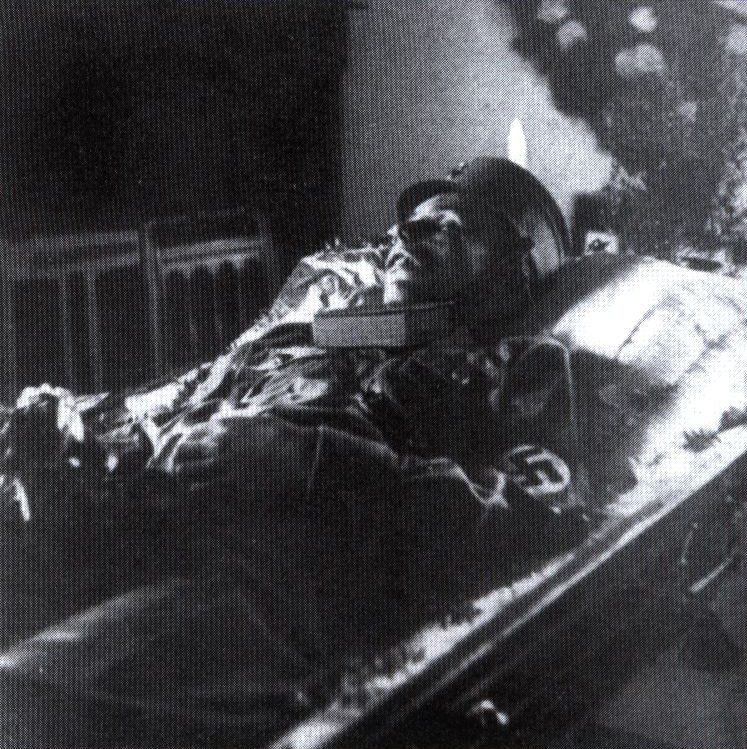
The dead Horst Hoffmann in an open coffin
On 1 February 1932, the court imposed prison sentences of between one and three years on the eleven defendants for bodily harm resulting in death. As the main perpetrator and leader of the left-wing group, Franz Bartowski received a prison sentence of two years and three months. Other persons received much lighter sentences for carrying weapons.
Horst Hoffmann was born in Danzig-Schidlitz and was an SA man in Neuendorf, Danziger Höhe district. The SA-Sturm 11/5 bore the name of the dead man, and the city of Danzig named the North Promenade after the fallen Sturmabteilungsmann.
During the trial, the following picture emerged of what happened on the night of the murder: On the evening of 15 November 1931, SA Storm 73, Mariensee is commanded with around seventy men as personal security for a National Socialist discussion speaker to a left-wing event in Danzig-Kahlbude. Security forces break up the meeting prematurely, however, as the Brown Shirts present considerably disrupt the evening of speeches by singing national songs and heckling. A short time later, the leader of the unit, Sturmführer Pawlowski, receives a report that his SA men are to be intercepted and attacked by left-wing „workers’ protection bundlers“. With a handful of his own forces, the SA leader then went towards some Schutzbündler standing by a jetty. As the Brown Shirts approached, the leftists fled, two of them jumping into the river Radaune and swimming away.
The way home of their own comrades is now to be secured in the long term. A squad of SA marches on the Chaussee in the direction of Löbau because they have dispersed, in order to determine the whereabouts of the opponents and to escort comrades at risk home. With the headlights on, a vehicle suddenly stops in front of the SA man Tanz. Near the Neuenbauer inn, several members of the left-wing group jump out of the car. Immediately the group tries to surround the individual. The uniformed man is able to flee at a run. Only minutes later, two SA men narrowly manage to escape from the vehicle crew. Out of nowhere, the car is suddenly in front of Sturmführer Pawlowski and the sixteen-year-old farmer’s son Horst Hoffmann. The headlights obscure the two from view. The attackers tear open the car doors and rush towards the SA men. Both sides hurriedly shout for reinforcements. About twenty leftists quickly approach. After being completely surrounded, Wiegand, a Workers’ Protection League member, beats Hoffmann until the young SA man collapses.
His assault leader pulls him up again and tries to push the boy out of the brawl. However, the assailants, armed with truncheons and blackjacks, push behind the two and separate them from each other.
Post, who was later sentenced to three years and four months in prison, holds Hoffmann by the arm with his left hand. With his right hand he repeatedly stabs the boy. One of the stabs penetrates the neck so deeply that the lung is severely injured. Bleeding and breathing heavily, Hoffmann collapses in the middle of the crowd after further blows. With the cry „Leave him, he’s had enough, don’t look at yourselves!“ the attackers acknowledge their triumph over the victim lying on the ground. The perpetrators dragged the helpless body to the side of the road, heaved it over a high hedge into the ditch and fled. When more Sturmableilungsmen arrive, they find the body of their young comrade. A short time later, Sturmführer Pawlowski identifies the leader of the left-wing group and others involved in the crime at the police station.
At the scene of the crime, the Sturmabteilung dedicates a memorial plaque to its fallen.
Erwin Moritz
(*2 April 1910, † 5 November 1931 in Berlin)
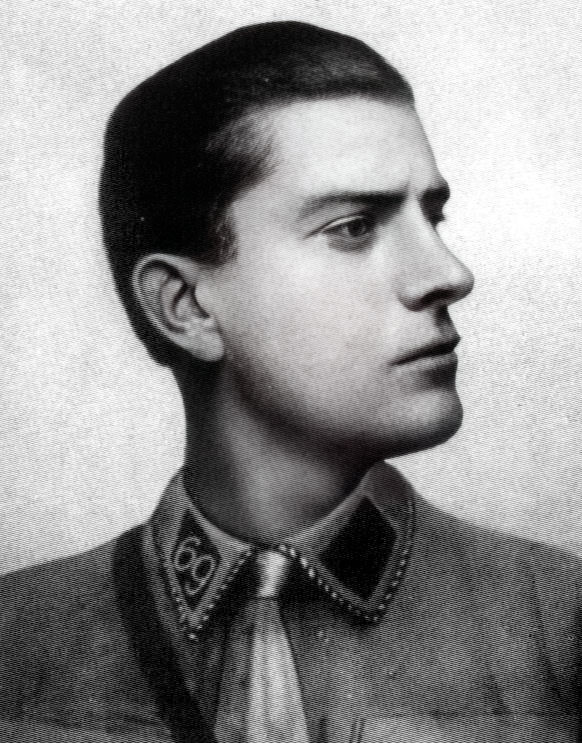
Erwin Moritz was a resistance fighter against the Weimar Republic and a Blood martyr to the National Socialist movement.
Erwin Moritz switched from the communists to the NSDAP and the SA. This earned him the hatred of the communists. On his way home from his fiancée’s on 5 November 1931, the twenty-one-year-old milker from Berlin was killed by two shots from communist cyclists in Graetzstraße. A memorial plaque was erected at the site of the murder during the Third Reich. The stele also erected in the current Karl-Kunger-Straße in Berlin bore the inscription:
Erwin Moritz,
born 2. 4. 1910,
SA man in storm 69,
shot by communists on 5. 11. 1931.
He fell for the liberation of his fatherland.
The newspaper Der Angriff wrote about the events:
Mother’s tears that are a reminder to us.
Last greeting to Erwin Moritz:
The Chief of Staff, Captain Röhm, representing Adolf Hitler at the grave of the murdered SA. comrade.
For the third time in two months, we stood yesterday afternoon at the Luisenstädt cemetery to pay our last respects to a comrade who was faithful even unto death. The cemetery is cordoned off by a small army of police. Outside this perimeter, the masses who do not yet belong to the chosen ones, to the fighters for freedom, honour and bread, are piling up. For them, too, the majesty of death has inspired awe before the sacrificial courage of the brown army and an inkling of what all the sacrifices are being made for. At the entrance, deeply veiled, stand a grief-stricken mother and a father with features full of hard seriousness. Indeed, it is obvious to these parents that their son belongs to the nobility of the nation. For through all their pain there is an upright pride and an inner strength that knows that this young man had to be one of the most blessed before the Lord in order to be allowed to die as a martyr for the sake of justice, as a Blood martyr for the good cause of his people, whose name will one day be one of the most honoured in a better Germany. Closely surrounding these sorely afflicted and yet so brave parents are the large number of the hero’s close relatives. Brother and sister and bride and brother-in-law. Timidly their feet tread, almost reluctantly, on the bitter path that lets them gaze for the last time into the yellow face of the dead, disfigured by murderer’s bullets. Silently he lies there in his brown robe of honour. His face, still noble and bold in death, bears almost no resemblance to the bad photographs we know of him. Motionless as black image columns, his comrades - a blossoming youth - hold the wake. And while the mother’s pain dissolves into tears, an anger rises up in us and a hatred without limits against the villains who did this to all of us. But we pull ourselves together, soon we will have the power, and then things will be different. We stand in the small chapel and listen to the consoling words of the priest, who has long since become our friend and brave admonisher, and whose warrior’s cross flashing from his gown testifies to the fact that he is not only a man of pious words, but also a hero of equally pious deeds. „Blessed are those who suffer and are persecuted for righteousness’ sake,“ he says to the dead man’s comrades. And he understands that this youth no longer has faith in the old, because it is their task to make good what the previous generation did so badly. Then muffled drums call for the final walk. Ahead is Storm 28, Storm Erwin Moritz. Then a forest of blood-red flags, behind which, in black shirts, the next comrades of the dead carry their expensive burden. So it goes through an endless line of SA and party comrades, who silently raise their arms in silent salute. Honoured like a prince? Are not our dead worth more than a prince, for here ten thousand hearts beat in genuine mourning and with the holy will to fulfil the dead man’s legacy. „Flame up!“ Serious and solemn the chapel’s playing sounds over the graves. The coffin descends, once more the eagles and storm flags and the outstretched arms salute. A final blessing and a mother who will never see her son again seeks comfort in the priest’s arms. „... Stay in eternal life, my good comrade.“ Dr Goebbels stands on the fresh grave. In the face of this tragedy he is at a loss for words. „We will not forget you and your murderers!“ That is all he can say here. On behalf of the Führer, who is in Hesse, and on behalf of the entire SA of Greater Germany, the Chief of Staff, Captain Röhm, lays two wreaths. On behalf of the Berlin SA, Count Helldorf sends his last greetings and pledge to the fallen comrade. Standartenführer Schwarz speaks in a shocking and deeply moving manner. Bring the five other fallen comrades of Standarte 3 our greetings and our sacred oath to fight and win. Then a balmy wind blows the banner of the Sturms 23 and a belated sunbeam bathes it all over in gold. Millions are already looking at the swastika full of hope. ..’ Wreath after wreath piles up around the grave, for a good hour. Then night falls over the garden of death and wraps the fresh grave in its merciful mantle. Silently a sleepless mother cries. And each of her tears is a reminder for us.
A street was named in his honour in Berlin-Treptow.
Wilhelm Decker
(* 4 December 1907, † 9 November 1931 in Bremen)
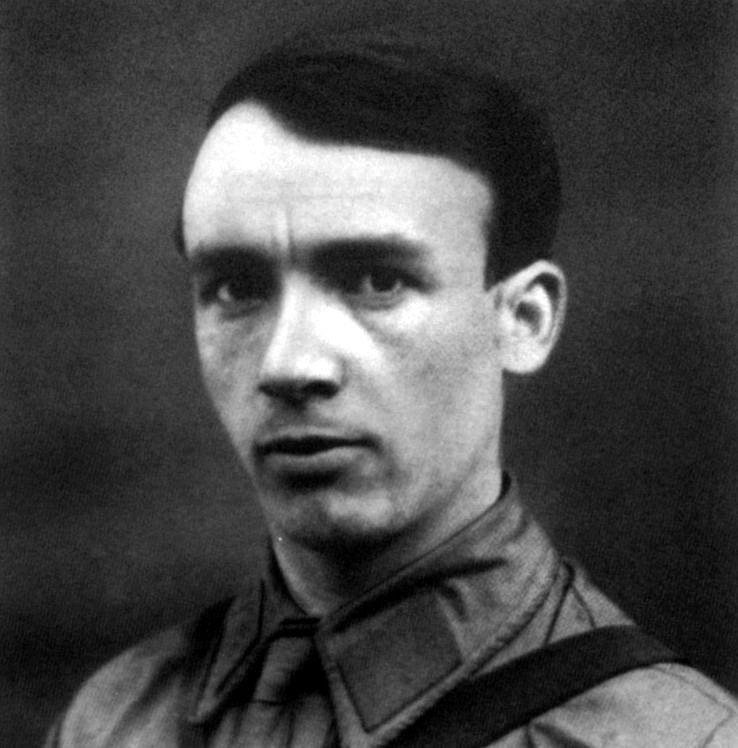
Wilhelm Decker was a resistance fighter against the Weimar Republic and a Blood martyr of the National Socialist movement.
On 9 November 1931, after a memorial service for the fallen comrades of 1923, the Bremen SA moves in small groups towards their homes, serious and inwardly moved. They do not think about the fact that roll-call squads have gathered in the „Workers’ Radio Club“ to attack the SA. Suddenly the SA men are attacked and stabbed by members of the Reichsbanner in uniform and by members of the Arbeiter-Samariter-Bund. Wilhelm Decker, who had just joined the SA, was stabbed through the heart and killed in Bornstraße in Bremen. A fierce battle ensues between twenty SA men and well over two hundred red murderers. Many seriously and lightly wounded remain lying in the square.
The obituary of his family contained the text:
In the fight for honour, truth, freedom and justice
In the struggle for a new, better Germany
was (...) Wilhelm Decker
in a raid instigated by political opponents.
stabbed to death by a nefarious hand on Monday evening.
A loyal German heart no longer beats.
In the subsequent so-called Bornstraßen trial against the murderers of the Reichsbanner, Roland Freisler appeared as the representative of the joint plaintiffs for the NSDAP.
The „Wilhelm-Decker-Haus“, the former Social Democratic People’s House, housed the German Labour Front during the Third Reich.
The Sturm 4/Standarte 75, Bremen, Gruppe Nordsee was given the honorary name „Wilhelm Decker.“
Decker was also commemorated by a boulder in „Waller Park“ and a plaque on a house „Am Wandrahm“. All these monuments were temporarily removed after the so-called „liberation“. The storm flag was taken to the VSA.
Karl Radke
(*18 September 1898, † 9 November 1931 in Eutin)
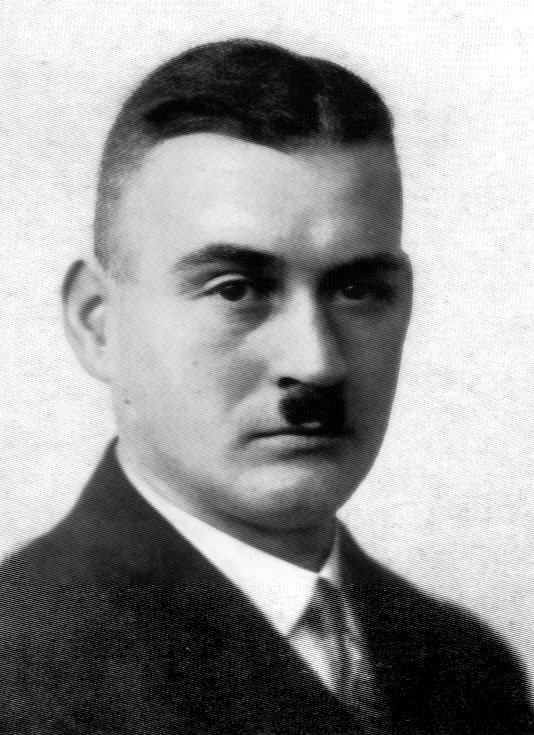
Karl Radke was a resistance fighter against the Weimar Republic and a Blood martyr of the National Socialist movement.
From being a war volunteer with the 1st Substitute Machine Gun Company in Hamburg, he finally made it to lieutenant (ret.) in three years of war through his own efficiency and bravery. He returned from the First World War in good health and took part in the Kapp Putsch in 1920. He was forced to bleed to death as a result of a stab wound inflicted by a Social Democratic murderer on 9 November 1931.
A funeral service was held for Radke in Eutin on 13.11.1931 in the Eutin riding hall. Radke was buried in Eckernförde. During the funeral service, which was preceded by a funeral procession, Böhmcker, a member of the city council and the Oldenburg state parliament, took the vows of his SA and SS men (the number is estimated at about one thousand) on the Eckernförde market square:
„Not to slacken in the fight for the unity and liberation of the German people and to take comrade Karl Radke as an example of loyalty [...]. [...], he has earned the right to be called a hero. Rest in peace, Karl Radke!“
A detailed investigation of the murder never took place under the Weimar system of justice. Only after the National Socialist victory in 1933 was the perpetrator convicted, and he served his sentence until 1948.
On the occasion of the first anniversary of Hitler’s appointment as Reich Chancellor, a bronze memorial plaque was unveiled at the Breede inn in Eutin, recording the death of SS man Karl Radke in Third Reich memory:
„ON 9.11.1931, HERE WAS
THE SS MAN
KARL RADKE
FROM REICHSBANNER-
MURDERERS STABBED
HE DIED FOR THE THIRD REICH.“
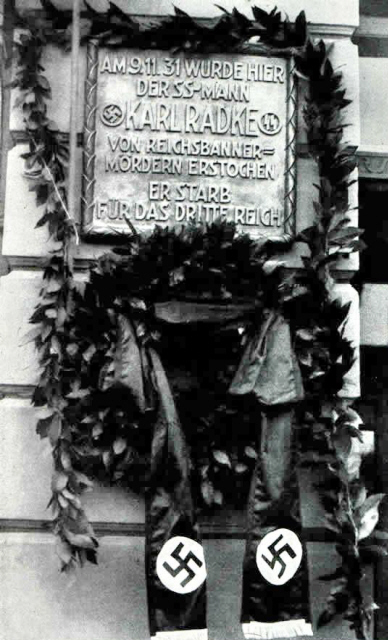
Memorial plaque at the murder site for Karl Radke,
Eutin, fallen on 9 November 1931
In Eckernförde, the former Friedrich-Ebert-Straße, in Flensburg the SS-Standartenheim bears the name of the fighter for Germany.
Martin Martens
(* 8 September 1909, † 11 November 1931 in Neumünster (Schleswig-Holstein))
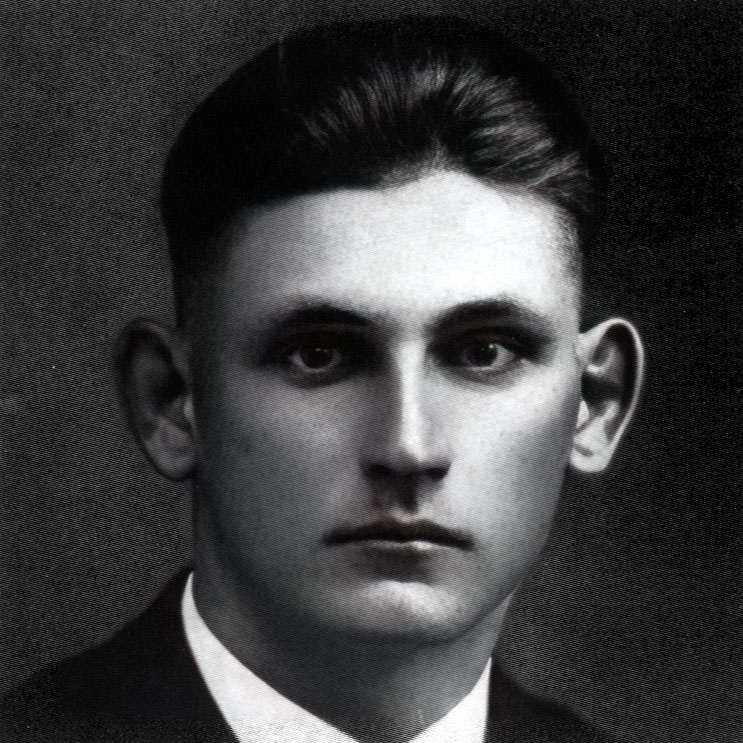
Martin Martens (* 8 September 1909, † 11 November 1931 in Neumünster (Schleswig-Holstein)) was a resistance fighter against the Weimar Republic and a Blood martyr of the National Socialist movement.
I know, my hot will to fight,
who gave me the power of sacrifice,
burns away in my grave’s silence....
I live! - And I never die!
The fire of the will, unfounded,
has elated you, all my people
and ignites the embers everywhere,
which brings light into Germany’s darkness.
That you may overcome the strife,
is beautiful crowning of my deed-
You too, who once stood at a distance,
You are now my comrade... Pidder Lüng
In memory, these verses were dedicated to the SS man Martin Martens, who was shot by the communist leader Weißig in Neumünster on 11 November 1931. He passionately embraced the National Socialist movement. Sunday after Sunday he was on the road. The tension that had been hanging over the political goings-on in Neumünster for some time finally came to a head. The conflicts took on an increasingly dangerous character. Party hatred gets the upper hand and claims victim after victim. Martens was on his way home from a meeting with some comrades when he was confronted by numerous communists. They clash and Martens is shot in the chest. The doctor Dr. Müller, who tries to help, is also hit. Nevertheless, Martin Martens is taken to the wounded doctor’s surgery on his instructions. When the SA men arrive there with the seriously injured man, the communist attackers also enter the hallway and try to continue beating the doomed man. While another six SA men are shot down in the process, Martin Martens dies of his severe wounding at the age of 22.
„He was rich in ideals“ - his relatives’ obituary read - „in the belief in a better future he gave his life in the fight for his homeland, in the fight for German being and being“.
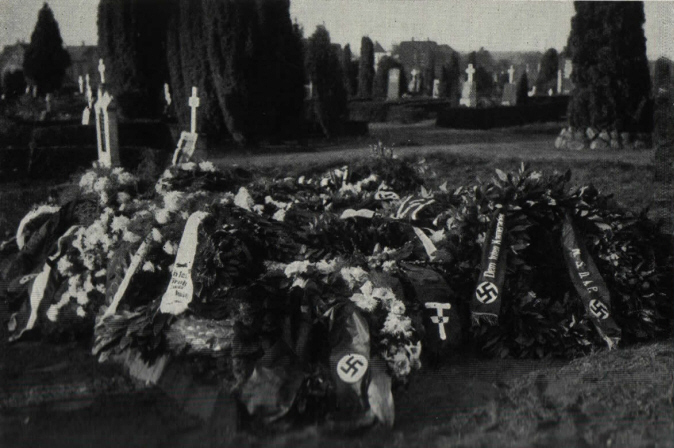
Martin Martens, Neumünster,
killed in action on 11 November 1931, rests here.
The communist murderer atones for his crime with a fifteen-year prison sentence. The square where the SS man was shot, the Gänsemarkt in Neumünster, was called „Martin-Martens-Platz“ in the Third Reich.
Walter Thriemer
(* 7 August 1907, † 11 November 1931 in Lugau i. Erzgebirge)

Walter Thriemer was a resistance fighter against the Weimar Republic and a Blood martyr to the National Socialist movement.
In 1931, Walter Thriemer became the first NSDAP and SA member in the left-wing village of Neuwiese between Chemnitz and Zwickau.
The Motor SA man Walther Thriemer from Neuwiese in Saxony was a young baker’s assistant. On 11 November 1931, he went on a motorbike ride to Lugau in the Ore Mountains, to an event in the restaurant „Goldene Sonne“. The later Saxon Gauführer of the NS Teachers’ Association, Göpfert, spoke under the motto „The war against people, state and family“.
In the course of the event, a call was received that a participant’s child had fallen ill and that the man should come home. The doors, which had been locked as a precaution, were opened. The murderers waiting outside took advantage of this situation and entered the hall. At the same moment, Walter Thriemer arrived on his motorbike coming from Oelsnitz. When he saw a comrade being threatened by communists and Reichsbanner people in front of the inn, he rushed to help him. He tried to protect the SA man Geßner, who was already seriously wounded, from further knife wounds. In the struggle Walter Thriemer received a fatal stab in the heart. The murderer, the communist Konietzny, was sentenced to two years and six months in prison by the Weimar system justice.
A former teacher of Walter Thriemer described him at a ceremony in 1934 as a conscientious, comradely pupil, polite, decent and modest.
The 2nd District School in Oelsnitz bore the honorary name of its former pupil Walter Thriemer School during the Third Reich.
Hans Hobelsberger
(* 8 August 1896, † 17 November 1931 in Worms)
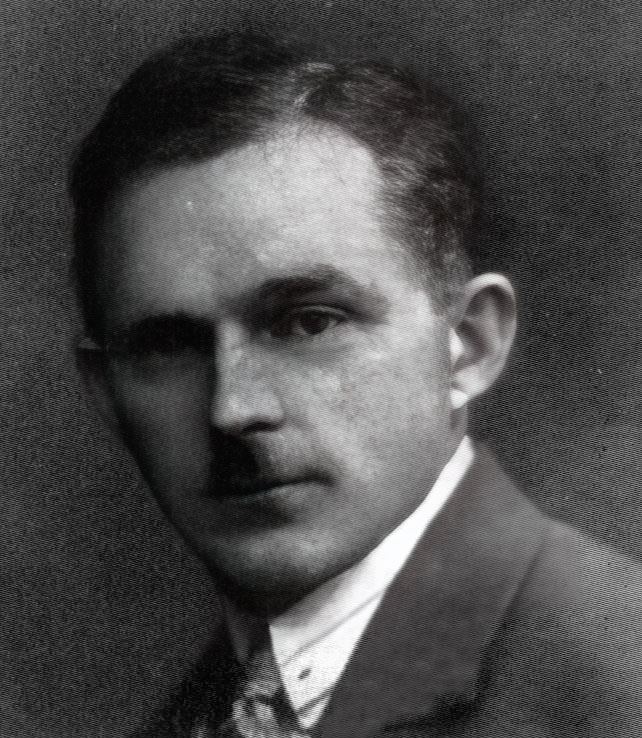
Hans Hobelsberger was a resistance fighter against the Weimar Republic and a Blood martyr of the National Socialist movement.
The SA squad leader Hans Hobelsberger from Biblis near Worms went out as a war volunteer at the age of eighteen, was wounded twice and awarded the Iron Cross I Class. After the First World War he was a traveller, then unemployed. He found his way to Adolf Hitler and joined the NSDAP. At a rally in Worms on 10 November 1931, he and three other comrades were attacked by communists. These, only 30 in number, quickly get reinforcements and number up to 100 when they attack the four National Socialists. The squad leader Hobelsberger and another SA man are pushed away. When the chain on Hans Hobelsberger’s bicycle breaks, they attack him. Badly injured by communist knife wounds and kicks, the father of three children died on 17 November 1931.
Egidius Geurten
(* 16 February 1908, † 20 November 1931 in Aachen)

Egidius Geurten was a resistance fighter against the Weimar Republic and a Blood martyr of the National Socialist movement.
On 20 November 1931, the civil engineering worker and SA man Egidius Geurten was beaten to death with stones on his way to a rally of about 30 members of the Iron Front. Together with two other comrades, he was on his way to a lecture by Reichstag member Josef Terboven under the heading:
Marxism is workers’ treason - National Socialism is workers’ liberation
Shortly before reaching the meeting, Egidius Geurten is pushed away by his two comrades. The police report later says that he was „literally stoned to death“.
A memorial leaf speaks of him:
A young worker, father of two children, SA man in the black and red Aachen of 1931! Laughed at, ridiculed, insulted, persecuted! What unbridled faith in the Führer, what boundless love for his people must have inspired this simple German man! And he had to go! To a horrible, horrible death. The Jew wanted it, and seduced comrades of the people were willing tools. The death of this simple German worker was not in vain. It was a wake-up call; at least it forced respect and recognition. The grave outside the gates of Aachen, not far from the border of the Reich, sent the power of the sacrificial death into the city and the country, fertilising and bringing blessings!